
DVD Home Theatre
System
Operating Instructions
??2010 Sony Corporation

DVD Home Theatre
System
Operating Instructions
??2010 Sony Corporation

WARNING
Caution ??? The use of optical instruments with this product will increase eye hazard.
Do not install the appliance in a confined space, such as a bookcase or
To reduce the risk of fire, do not cover the ventilation opening of the apparatus with newspapers, tablecloths, curtains, etc. Do not place the naked flame sources such as lighted candles on the apparatus. To reduce the risk of fire or electric shock, do not expose this apparatus to dripping or splashing, and do not place objects filled with liquids, such as vases, on the apparatus. Do not expose batteries or apparatus with
To prevent injury, this apparatus must be securely attached to the floor/wall in accordance with the installation instructions.
Indoor use only.
This appliance is classified as a CLASS 1 LASER product. This marking is located on the rear exterior.
Disposal of
Old Electrical & Electronic
Equipment (Applicable in
the European Union and other European countries with separate collection systems)
This symbol on the product or on its packaging indicates that this
product shall not be treated as household waste. Instead it shall be handed over to the applicable collection point for the recycling of electrical and electronic equipment. By ensuring this product is disposed of correctly, you will help prevent potential negative consequences for the environment and human health, which could otherwise be caused by inappropriate waste handling of this product. The recycling of materials will help to conserve natural resources. For more detailed information about recycling of this product, please contact your local Civic Office, your household waste disposal service or the shop where you purchased the product.
Disposal of waste batteries
(applicable in the European
Union and other European countries with separate collection systems)
This symbol on the battery or on the packaging indicates that the battery provided with this product shall not be treated as household waste. On certain batteries this symbol might be used in combination with a chemical symbol. The chemical symbols for mercury (Hg) or lead (Pb) are added if the battery contains more than 0.0005% mercury or 0.004% lead. By ensuring these batteries are disposed of correctly, you will help prevent potentially negative consequences for the environment and human health which could otherwise be caused by inappropriate waste handling of the battery. The recycling of the materials will help to conserve natural resources. In case of products that for safety, performance or data integrity reasons require a permanent connection with an incorporated
battery, this battery should be replaced by qualified service staff only. To ensure that the battery will be treated properly, hand over the product at
Notice for customers: the following information is only applicable to equipment sold in countries applying EU directives.
The manufacturer of this product is Sony Corporation,
???Nadz??r nad dystrybucj?? na terytorium Rzeczypospolitej Polskiej sprawuje Sony Poland,
2GB

Precautions
On power sources
???The unit is not disconnected from the mains as long as it is connected to the AC outlet, even if the unit itself has been turned off.
???As the main plug is used to disconnect the unit from the mains, connect the unit to an easily accessible AC outlet.
Should you notice an abnormality in the unit, disconnect the main plug from the AC outlet immediately.
Copyrights
This product incorporates copyright protection technology that is protected by U.S. patents and other intellectual property rights. Use of this copyright protection technology must be authorized by Macrovision, and is intended for home and other limited viewing uses only unless otherwise authorized by Macrovision. Reverse engineering or disassembly is prohibited.
This system incorporates with Dolby* Digital and Dolby Pro Logic (II) adaptive matrix surround decoder and the DTS** Digital Surround System.
*Manufactured under license from Dolby Laboratories. Dolby, Pro Logic, and the
**Manufactured under license under U.S. Patent #???s: 5,451,942; 5,956,674; 5,974,380; 5,978,762; 6,487,535 & other U.S. and worldwide patents issued & pending. DTS
and DTS Digital Surround are registered trademarks and the DTS logos and Symbol are trademarks of DTS, Inc. ?? 1996- 2008 DTS, Inc. All Rights Reserved.
This system incorporates High- Definition Multimedia Interface (HDMITM) technology.
HDMI, the HDMI logo and
???BRAVIA??? is a trademark of Sony Corporation.
???PLAYSTATION??? is a trademark of Sony Computer Entertainment Inc.
ABOUT DIVX VIDEO: DivX?? is a digital video format created by DivX, Inc. This is an official DivX Certified device that plays DivX video. Visit www.divx.com for more information and software tools to convert your files into DivX video.
(Except for United Kingdom and North American models.)
ABOUT DIVX
DEMAND:
This DivX Certified?? device must be registered in order to play DivX
code to complete the registration process and learn more about DivX VOD. (Except for United Kingdom and North American models.)
DivX?? is a registered trademark of DivX, Inc., and is used under license.
(Except for United Kingdom and North American models.)
MPEG
iPod is a trademark of Apple Inc., registered in the U.S. and other countries.
(United Kingdom models only)
???Made for iPod??? means that an electronic accessory has been designed to connect specifically to iPod and has been certified by the developer to meet Apple performance standards.
(United Kingdom models only)
Apple is not responsible for the operation of this device or its compliance with safety and regulatory standards.
(United Kingdom models only)
About
THIS PRODUCT IS
LICENSED UNDER THE
PORTFOLIO LICENSE FOR
THE PERSONAL AND NON-
COMMERCIAL USE OF A
CONSUMER FOR
3GB

DECODING VIDEO IN
COMPLIANCE WITH THE
VIDEO???) THAT WAS
ENCODED BY A
CONSUMER ENGAGED IN
A PERSONAL AND NON-
COMMERCIAL ACTIVITY
AND/OR WAS OBTAINED
FROM A VIDEO PROVIDER
LICENSED BY MPEG LA TO
PROVIDE
NO LICENSE IS GRANTED
OR SHALL BE IMPLIED
FOR ANY OTHER USE.
ADDITIONAL
INFORMATION
INCLUDING THAT
RELATING TO
PROMOTIONAL,
INTERNAL AND
COMMERCIAL USES AND
LICENSING MAY BE
OBTAINED FROM MPEG LA, LLC. SEE HTTP://
WWW.MPEGLA.COM
About These
Operating
Instructions
???The instructions in these Operating Instructions describe the controls on the remote. You can also use the controls on the unit if they have the same or similar names as those on the remote.
???The Control Menu items may vary depending on the area.
??????DVD??? may be used as a general term for a DVD VIDEO, DVD+RW/ DVD+R, and
???Measurements are expressed in feet (ft) for North American models.
???The default setting is underlined.
???The system is compatible with the
???Notes or instructions for the
4GB

5GB

Playable Discs/Files on a USB Device
6GB

1)A logical format of files and folders on
2)MP3 (MPEG1 Audio Layer 3) is a standard format defined by ISO/MPEG for compressed audio data. MP3 files must be in MPEG1 Audio Layer 3 format.
3)Files with copyright protection (Digital Rights Management) cannot be played by the system.
4)JPEG image files must conform to the DCF image file format. (DCF ???Design rule for Camera File system???: Image standards for digital cameras regulated by Japan Electronics and Information Technology Industries Association (JEITA).)
5)Except for United Kingdom and North American models.
6)Except for North American models.
Notes on discs
This product is designed to playback discs that conform to the Compact Disc (CD) standard. DualDiscs and some music discs encoded with copyright protection technologies do not conform to the Compact Disc (CD) standard. Therefore, these discs may not be compatible with this product.
Example of discs that the system cannot play
The system cannot play the following discs:
???
???
???Data part of
???CD Graphics disc
???DVD Audio
???DATA CD/DATA DVD that does not contain MP3 files, JPEG image files, DivX video files*, or MPEG4 video files**
???DATA CD/DATA DVD that is created in Packet Write format
???
???
*Except for United Kingdom and North American models.
**Except for North American models.
Also, the system cannot play the following discs:
???A DVD VIDEO with a different region code (page 8)
???A disc that has a
???A disc with paper or stickers on it
???A disc that has the adhesive of cellophane tape or a sticker stuck on it
7GB

Notes about
In some cases,
The disc will not play if it has not been correctly finalized. For more information, refer to the operating instructions for the recording device.
Note that some playback functions may not work with some DVD+RWs/DVD+Rs, even if they have been correctly finalized. In this case, view the disc by normal playback. Also some DATA CDs/DATA DVDs created in Packet Write format cannot be played.
Notes about Multi Session CD
???This system can play a Multi Session CD when an MP3 file is contained in the first session. Any subsequent MP3 files recorded in later sessions can also be played.
???This system can play a Multi Session CD when a JPEG image file is contained in the first session. Any subsequent JPEG image files recorded in later sessions can also be played.
???If MP3 files and JPEG image files in music CD format or video CD format are recorded in the first session, only the first session will be played.
Region code
Your system has a region code printed on the rear of the unit and will only play a DVD labeled with the same region code.
A DVD VIDEO labeled ALL will also play on this system.
If you try to play any other DVD VIDEO, the message [Playback prohibited by area limitations.] will appear on the TV screen. Depending on the DVD VIDEO, no region code indication may be given even though playing the DVD VIDEO is prohibited by area restrictions.
Notes about playback operations of a DVD or VIDEO CD
Some playback operations on a DVD or VIDEO CD may be intentionally set by software producers. Since this system will play a DVD or VIDEO CD according to the disc contents the software producers designed, some playback features may not be available. Be sure to read the operating instructions of the DVD or VIDEO CD.
Notes about playable files
???The system can recognize up to 200 folders, including albums (folders) that do not contain audio files, JPEG image files, or video files1). When more than 200 folders are on the DATA CD/DATA DVD/
USB device or more than 150 files are in a folder, folders/files that are recognized by the system differ depending on the folder configuration.
8GB

??? The system can play the following files.
The system will attempt to play any data with the extensions above, even if it is not in MP3/WMA/ AAC/JPEG/DivX3)/MPEG41) format. Playing this data may generate a loud noise which could damage your speaker system.
???The following can increase the time it takes to start playback:
???when a DATA CD/DATA DVD/USB device is recorded with a complicated tree structure.
???when the audio files, JPEG image files, or video files1) in another folder have just been played.
???Some files on DATA CDs/DATA DVDs/USB devices cannot be played by the system depending on the file format.
???The system can play to a depth of 8 folders only.
???The system may not be able to play an audio file, JPEG image file, or video file1) depending on the file type.
???Files recorded by a device such as a computer may not be played in the order in which they were recorded.
???Folders that have no audio files, JPEG image files, or video files1) are skipped.
???Compatibility with all MP3/WMA/AAC encoding/writing software, recording devices, and recording media cannot be guaranteed.
???Compatibility with all MPEG4 video encoding/writing software, recording devices, and recording media cannot be guaranteed.1)
???The playback order may not be applicable depending on the software used for creating the audio file, JPEG image file, or video file1), or if there are more than 200 folders or 150 files in each folder.
1)Except for North American models.
2)USB device only.
3)Except for United Kingdom and North American models.
About DivX video files
(Except for United Kingdom and North American models)
???DivX?? is a video file compression technology, developed by DivX, Inc. This product is an official DivX?? Certified product.
???You can play a DATA CD/DATA DVD/USB device that contains DivX?? video files.
Note
???The system may not play a DivX video file when the file has been combined from two or more DivX video files.
???The system cannot play a DivX video file larger than 720 (width) ?? 576 (height) or 4GB.
???Depending on the DivX video file, sound may skip or not match the pictures on the TV screen.
???The system cannot play some DivX video files that are longer than 3 hours.
???Depending on the DivX video file, the picture may pause or be unclear, in which case it is recommended that you create the file at a lower bit rate. If the sound is noisy, MP3 is the recommended audio format.
???Because of the compression technology used for DivX video files, it may take some time after you press N for the picture to appear.
9GB

Notes about USB devices
???This system supports Mass Storage Class (MSC) devices.
???This system is not guaranteed to operate with all USB devices or memories.
???Although there are variety of complex functions for USB devices, the playable contents of USB devices connected to the system are music, photo, and video contents only. For details, refer to the operating instructions of the USB device.
???When a USB device is inserted, the system reads all the files on the USB device. If there are many folders or files on the USB device, it may take a long time to finish reading the USB device.
???Do not connect the system and the USB device through a USB hub.
???With some connected USB devices, there may be a delay before an operation is performed by this system.
???The playback order for the system may differ from the playback order of the connected USB device.
???Always turn off the system before removing the USB device. Removing the USB device while the system is on may corrupt the data on the USB device.
???Before using a USB device, make sure that no
10GB

Package Contents
Main unit
Speaker packages
??? Foot pads (1 set)
???Speaker assembly parts for the tall speakers For
11GB

Index to Parts and Control
For more information, refer to the pages indicated in parentheses.
Front panel
A Disc tray
B Front panel display (page 13)
C  (remote sensor)
(remote sensor)
DMASTER VOLUME control
Adjusts the system???s volume.
EREC TO USB (page 57)
Transfers tracks/MP3 files onto a USB device.
Lights up during transfer of tracks/MP3 files.
F  (USB) port (pages 28, 33)
(USB) port (pages 28, 33)
Used for connecting a USB device or iPod*.
* United Kingdom models only.
GAUDIO IN jack (page 28)
Used for connecting other components, such as a portable audio source.
HA.CAL MIC jack (page 30)
Used for connecting the calibration mic.
IFUNCTION
Selects the playback source.
JPlay operation buttons
Z (open/close)
Opens or closes the disc tray.
N (play)
Starts or
x (stop)
Stops playback and remembers the stop point (resume point).
K"/1 (on/standby)
Turns on the unit, or sets it to standby mode.
12GB

Front panel display
A Playing status indicator
BSLEEP indicator
Flashes when the sleep timer is set.
C System status display
DTUNED indicator (Radio only)
Lights up when a station is received.
EST indicator (Radio only)
Lights up when stereo sound is received.
F
Lights up during wireless transmission. Flashes when
GHDMI indicator
Lights up when a signal is established between a TV and the unit via HDMI.
H Surround format indicator
INTSC indicator
Lights up when an NTSC disc is loaded.
J
Lights up when a Super Audio CD/CD is loaded.
13GB
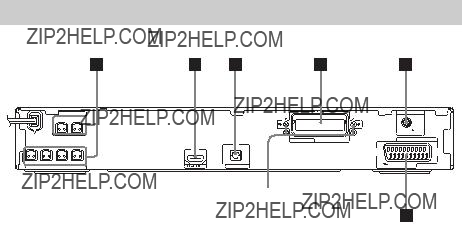
Rear panel
A SPEAKERS jacks (page 25)
B HDMI OUT jack (page 26)
CTV (DIGITAL IN OPTICAL) jack (page 26)
D
EANTENNA (COAXIAL 75?? FM) jack (page 28)
FEURO AV TOUTPUT (TO TV) jack (page 26)
*  CAUTION
CAUTION
Please do not remove the screws unless you are installing the
14GB

Remote control
6SHIFT
Number 5/AUDIO IN, VOLUME +, AUDIO, and N buttons have a tactile dot. Use the tactile dot as a reference when operating the remote.
ATHEATRE (page 51)
Switches to the optimum video mode for watching movies automatically.
Activates
TV "/1 (on/standby)*
Turns on your TV or sets it to standby mode.
"/1 (on/standby) (page 30)
Turns on the system or sets it to standby mode.
BButtons with black/white text labels
Function selection buttons (pages 33, 43, 46)
Select the playback source.
The system is turned on automatically when you press the function selection button while the system is turned off.
DVD/CD
FM
USB
TV
AUDIO IN
FUNCTION
Selects the functions in sequence.
TIME/TEXT (page 42)
Changes the information in the front panel display.
SOUND MODE (page 50)
Selects the sound mode.
SYSTEM MENU (pages 46, 48, 53, 59, 61)
Enters the system menu.
AUDIO (page 37)
Selects the audio format/track.
SUBTITLE (page 37)
Selects the subtitle language when multilingual subtitles are recorded on a
DVD VIDEO.
ANGLE (page 37)
Switches to other viewing angles when
VIDEO.
D.TUNING (page 46)
Selects the radio frequencies.
MEM SEL (pages 33, 57)
Selects the USB device???s memory number for playback or transfer.
15GB

CButtons with pink text labels (The
following buttons work when you press and hold SHIFT (6).)
Number buttons (pages 36, 46)
Enters the title/chapter numbers, radio frequencies, etc.
CLEAR (pages 35, 39, 59)
Clears the entry field.
TV INPUT*
Switches your TV???s input source.
DMUTING
Turns off the sound temporarily.
VOLUME +/??? (page 33)
Adjusts the volume.
EPlayback operation buttons
See ???Other Playback Operations??? (page 35).
./> (previous/next)
m/M (fast reverse/fast forward)  /
/ (slow)
(slow)
N (play)
X (pause) x (stop)
Radio operation buttons
See ???Listening to the Radio??? (page 46).
PRESET +/???
TUNING +/???
FSHIFT
Press and hold this button to use buttons with pink text labels (3).
GDVD TOP MENU (page 38)
Opens or closes the DVD???s Top Menu.
DVD MENU (page 38)
Opens or closes the DVD???s menu.
C/X/x/c
Moves the highlight to a displayed item.
 (ENTER)
(ENTER)
Enters the selected item.
O RETURN (page 34)
Returns to the previous display.
 DISPLAY (pages 17, 30, 33, 35, 39, 51, 57, 62)
DISPLAY (pages 17, 30, 33, 35, 39, 51, 57, 62)
Displays the playback information on the TV screen.
*Works with Sony TVs only. Depending on your TV, you may not be able to use some of the buttons.
To insert the batteries
Insert two R6 (size AA) batteries (supplied) by matching the 3 and # ends on the batteries to the markings inside the compartment.
???Do not leave the remote in an extremely hot or humid place.
???Do not use a new battery with an old one.
???Do not drop any foreign object into the remote casing, particularly when replacing the batteries.
???If you do not intend to use the remote for an extended period of time, remove the batteries to avoid possible damage from battery leakage and corrosion.
16GB

Guide to the Control Menu
You can use the Control Menu to select a function and to view related information.

 DISPLAY
DISPLAY
Press  DISPLAY while using the ???DVD/CD??? or ???USB??? function.
DISPLAY while using the ???DVD/CD??? or ???USB??? function.
Each time you press  DISPLAY, the Control Menu changes:
DISPLAY, the Control Menu changes:
1 t 2 t 3 t 1 t ...
1 Control Menu 1
2 Control Menu 2 (appears when available)
3 Control Menu off
17GB

Control Menu
Example: Control Menu 1 when playing a DVD VIDEO.
Currently playing title number
Currently playing chapter number
Control Menu items
Total number of titles
Total number of chapters
Playback status (N Playback, X Pause,
x Stop, etc.)
Selected item
Function name of selected Control Menu item
Type of source being played
Playing time
Current setting
Options
Operation message
List of Control Menu items
The Control Menu 1 and 2 will show different items depending on the source. For details, see the pages in parentheses in the chart below.
[TITLE] (page 36)/[SCENE] (page 36)/[TRACK] (page 36)
You can select the title, scene, or track to be played.
[CHAPTER] (page 36)/[INDEX] (page 36)
You can select the chapter or index to be played.
[INDEX] (page 36)
You can display the index and select the index to be played.
[TRACK] (page 36)
You can select the track to be played.
[ORIGINAL/PLAY LIST] (page 38)
You can select the type of titles 

[TIME] (page 36)
You can check the elapsed time and the remaining playback time.
You can play from a desired point by inputting the time code (DVD
[MULTI/2CH] (page 38)
You can select the playback area on a Super Audio CD when available.
[SUPER AUDIO CD/CD LAYER] (page 38)
You can select the playback layer on a Super Audio CD when available.
18GB

[PROGRAM] (page 39)
You can select the track to play in the order you want.
[SHUFFLE] (page 40)
You can play the tracks/files in random order.
[REPEAT] (page 40)
You can play the entire disc/USB device (all titles/all tracks/all folders/all files) repeatedly or one title/chapter/track/folder/file repeatedly.
[A/V SYNC] (page 59)
You can adjust the delay between the picture and sound.
[DISC MENU] (page 38)
You can display the DVD???s menu.
[BROWSING] (page 34)
You can display the list of folders/JPEG image files.
[SETUP] (page 62)
[CUSTOM]
In addition to the Quick Setup setting, you can adjust various other settings. [QUICK] (page 30)
You can make basic adjustments. Use the Quick Setup to select the desired language of the
[FOLDER] (page 36)
You can select the folder to be played.
[FILE] (page 36)
You can select the JPEG image file or video file to be played.
1)[DATE] (page 43)
You can display the date the picture was taken by a digital camera.
1)[INTERVAL] (page 41)
You can select the duration for which the slides are displayed on the TV screen.
1)[EFFECT] (page 41)
You can select the effects to be used for changing slides during a slide show.
[MEDIA] (page 35)
You can select the playback priority of different types of media (MP3/AAC2)/WMA2) file,
JPEG image file, video file, or both MP3 and JPEG image files3)) to be played on a DATA CD/DATA DVD/USB device. 





[USB TRANSFER] (page 57)
You can transfer tracks on an audio CD or MP3 files on a DATA CD/DATA DVD onto a USB device. 
1)These items are not displayed when playing a DATA CD/DATA DVD/USB device with video files.
2)USB device only.
3)DATA CD/DATA DVD only.
Tip
???The Control Menu icon indicator lights up in yellow  t
t  when you select any item except [OFF] ([PROGRAM], [SHUFFLE], [REPEAT], and [A/V SYNC] only). The [ORIGINAL/PLAY LIST] indicator lights
when you select any item except [OFF] ([PROGRAM], [SHUFFLE], [REPEAT], and [A/V SYNC] only). The [ORIGINAL/PLAY LIST] indicator lights
up in yellow when you select [PLAY LIST] (default setting). The [MULTI/2CH] indicator lights up in yellow when you select the
19GB

Getting Started
Getting Started
Step 1: Installing the System
How to position the system
Install the system by referring to the illustration below.
GG Unit
DE
To attach the foot pads to the subwoofer
,
Remove the foot pads from the protective cover.
Note
???Use caution when placing the speakers and/or speaker stands attached to the speakers on a specially treated (waxed, oiled, polished, etc.) floor, as staining or discoloration may result.
Assembling the speakers
For assembling the speakers refer to ???Speaker Installation Guide??? (supplement).
20GB

When installing the speakers on a wall
Caution
???Contact a screw shop or installer for information regarding the wall material or screws to be used.
???Use screws that are suitable for the wall material and strength. As a plaster board wall is especially fragile, attach the screws securely to a beam. Install the speakers on a vertical and flat wall where reinforcement is applied.
???Sony is not responsible for accidents or damage caused by improper installation, insufficient wall strength or improper screw installation, natural calamity, etc.
Before installing the tall speaker on a wall
You cannot install the tall speaker with the lower part attached. Be sure to remove the lower part of the tall speaker before installing the tall speaker on a wall.
1 Pull out the speaker cord from the slot of the rear of the speaker.
Speaker cord
,
Rear of the speaker
2 Disconnect the speaker cords from the speaker.
Rear of the speaker
Started Getting
21GB

3 Remove the screw
Getting Started
Screw
Rear of the speaker
4 Lift the upper part of the speaker.
Upper part of the speaker
Upper part
,
Lower part
Rear of the speaker
5 Pull out the speaker cord from the bottom of the lower part of the speaker.
The removed speaker cord is used when installing the speaker on a wall.
Lower part of the speaker
Speaker cord
,,
 Speaker cord
Speaker cord
22GB

6 Remove the protection paper from the
,  ,
,
Protection paper
Note
??? When removing the protection paper, pull it off via the section exposed by the notch in the
To hang the speaker on a wall
1 Connect the speaker cord with the color tube to 3, and the speaker cord without the color tube to #.
Color tube
Front left speaker (L): White
Front right speaker (R): Red
Center speaker: Green
Surround left speaker (L): Blue
Surround right speaker (R): Gray
2 Prepare screws (not supplied) that are suitable for the hole on the back of each speaker. See the illustrations below.
Started Getting
23GB
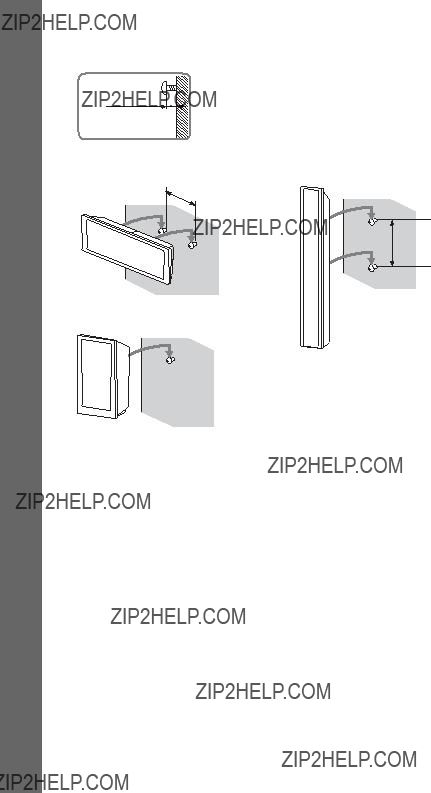
Getting Started
3 Fasten the screws to the wall, then hang the speaker on the wall.
Depth of fastened screw
8 to 10 mm (11/32 to 13/32 inch)
145 mm
(5 3/4 inches)
210 mm
(8 3/8 inches)
For the small speakers
24GB
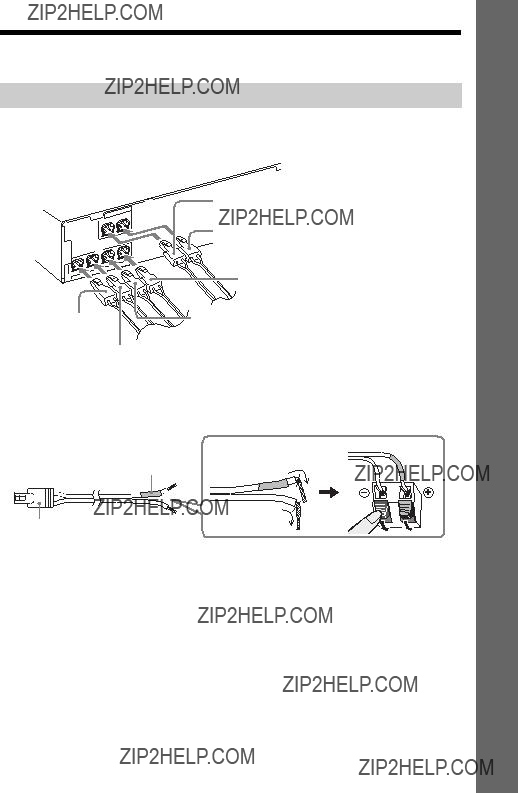
Step 2: Connecting the System
Connecting the speakers
1 Insert the connectors of the speaker cords to match the color of the SPEAKERS jacks of the unit until they click.
Gray
(Surround right speaker (R))
White
(Front left speaker (L))
2 Connect the speaker cord with the color tube to 3, and the speaker cord without the color tube to #.
The subwoofer speaker cord is fixed to the subwoofer.
Rear of the speaker
Color tube (+)
Started Getting
Connector
Note
??? Do not catch the speaker cord insulation (rubber covering) in the speaker terminals.
25GB

Getting Started
Connecting your
1 Connecting the video to your TV
Depending on the jacks on your TV, select one of the connection methods.
x Method 1: SCART (EURO AV) cable (not supplied) connection
This is the basic connection and sends both video and audio signals (analog stereo).
x Method 2: HDMI cable (not supplied) connection
Picture quality will be improved compared to Method 1.
If your TV is compatible with the Audio Return Channel function, this connection also sends a digital audio signal from the TV. You do not need to make a separate audio connection for listening to TV sound. For details of the Audio Return Channel function, see ???Receiving the digital audio signal of your TV??? (page 52).
ARC


Method 1 (not supplied)
Method 2 (not supplied)
26GB

2 Connecting the audio from your
To listen to TV or
xMethod 1: SCART (EURO AV) cable (not supplied) connection (for TV connection only)
For this connection, see Method 1 of ???1 Connecting the video to your TV.???
xMethod 2: Digital optical cord (not supplied) connection
This connection sends a digital audio signal from your
DIGITAL
IN
Note
???The system can accept both digital and analog signals. Digital signals have priority over analog signals. If the digital signal ceases, the analog signal will be processed after a few seconds.
Tip
???You can connect another component, such as a VCR, digital satellite receiver, or PlayStation, to the TV jack instead of your TV.
Started Getting
27GB
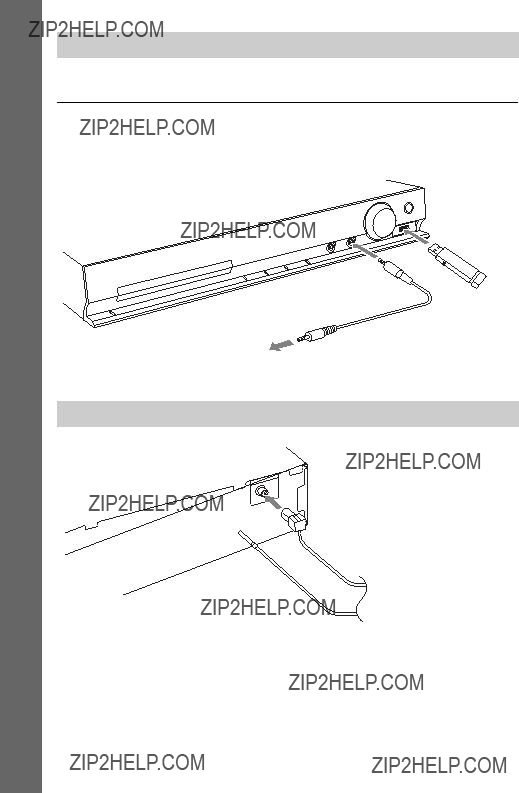
Getting Started
Connecting the other components
You can enjoy connected components via the system???s speakers.
B
A 
To a portable audio source.
Connecting the antenna (aerial)
or
FM wire antenna (aerial) (supplied)
Note
???After connecting the FM wire antenna (aerial), extend and keep it as horizontal as possible.
28GB
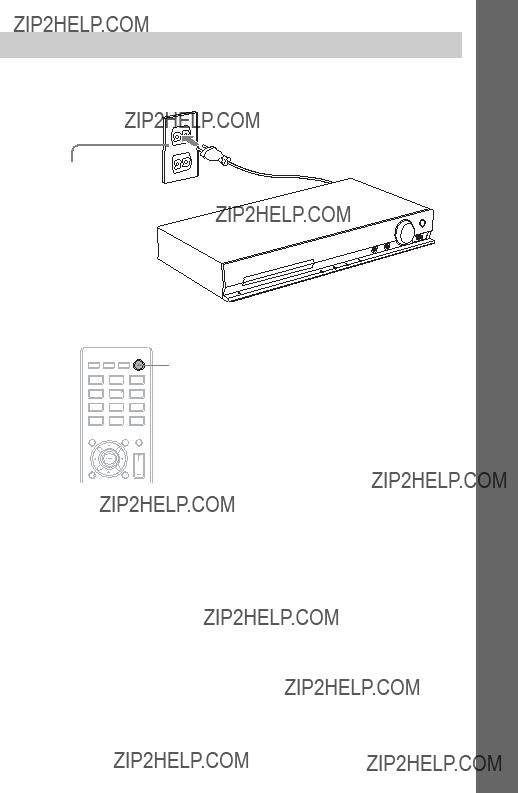
Connecting the AC power cord (mains lead)
1 Connect the AC power cord (mains lead).
The demonstration appears in the front panel display.
Wall outlet (mains): The shape of the wall outlet (mains) differs depending on the area.
2 Press "/1 to turn the system on, then press "/1 again to turn off the demonstration.
"/1
Started Getting
29GB
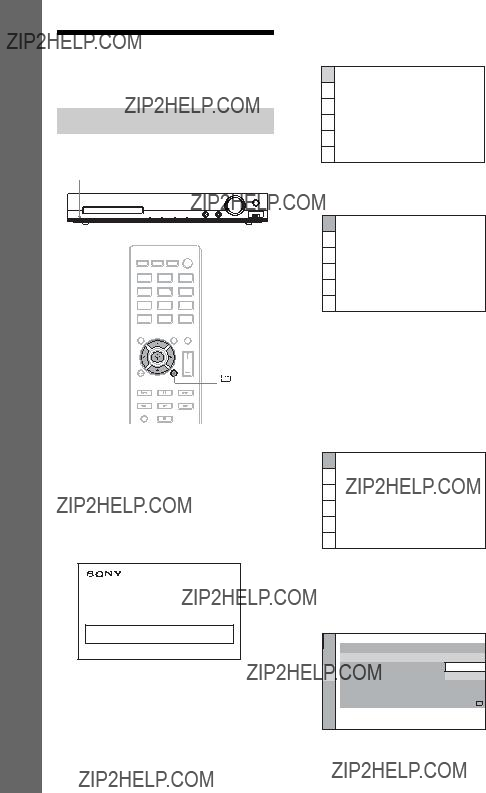
Getting Started
Step 3: Setting up the System
Performing the Quick Setup
Displayed items vary depending on the area.
"/1
5 Press X/x to select a language, then press  .
.
LANGUAGE SETUP
6 Press X/x to select the setting that matches your TV type, then press  .
.
VIDEO SETUP
C/X/x/c, 

DISPLAY
7
1
2
3 Press "/1 to turn the system on.
4 Press  without inserting a disc or connecting a USB device.
without inserting a disc or connecting a USB device.
8
Home Theatre System
Press ENTER to run QUICK SETUP.
Press CLEAR to erase this message.
Note
???If this message does not appear, press DVD/CD. If this message still does not appear, recall the Quick Setup display (page 61).
???[16:9]: This aspect ratio is for a wide- screen TV or a 4:3 standard TV with a
???[4:3 LETTER BOX] or [4:3 PAN SCAN]: This aspect ratio is for a 4:3 standard TV (page 63)
Press X/x to select the output method for video signals, then press  .
.
VIDEO SETUP
???[VIDEO]: Outputs video signals.
???[RGB]: Outputs RGB signals.
Press X/x to select the Control for
HDMI setting, then press  .
.
30GB

???[OFF]: The Control for HDMI function is set to off.
???[ON]: The Control for HDMI function is set to on.
9 Press C/c to select the speaker formation image as the speakers are actually positioned, then press  .
.
SPEAKER FORMATION
STANDARD
???[STANDARD]: Select this when you install all the speakers normally.
???[NO CENTER]: Select this when you install the front and surround speakers only.
???[NO SURROUND]: Select this when you install the center and front speakers only.
???[FRONT ONLY]: Select this when you install the front speakers only.
???[ALL FRONT]: Select this when you install all the speakers in front of the listening position.
???[ALL FRONT - NO CENTER]: Select this when you install the front and surround speakers in front of the listening position.
10 Connect the calibration mic (supplied) to the A.CAL MIC jack on the front panel.
Set up the calibration mic at ear level using a tripod, etc. (not supplied).
The front of each speaker should face the calibration mic, and there should be no obstruction between the speakers and the calibration mic.
Started Getting
Calibration mic
11 Press C/c to select [YES], then press
 .
.
Be quiet during the measurement.
Note
???Loud test sounds are output when [AUTO CALIBRATION] starts. You cannot turn the volume down. Give consideration to children and neighbors.
???The environment of the room in which the system is installed may affect measurements. When the measurements differ considerably from the status of the speaker installation, perform the speaker settings manually by following ???Settings for the speakers??? (page 67).
12 Unplug the calibration mic, press C/c to select [YES], then press  .
.
To quit the Quick Setup
Press  DISPLAY in any Step.
DISPLAY in any Step.
31GB

Getting Started
Setting the type of video output to match your TV
Depending on the connection of your TV (page 26), select the type of video output of the system.
To select the type of video signal output from the HDMI OUT jack
When you connect the unit and your TV with an HDMI cable, select the type of video signals output from the HDMI OUT jack.
1 Press DVD/CD.
2 Press  DISPLAY while the system is in stop mode.
DISPLAY while the system is in stop mode.
3 Press X/x to select  [SETUP], then press
[SETUP], then press  .
.

 CUSTOM
CUSTOM
4 Press X/x to select [CUSTOM], then press  .
.

 CUSTOM
CUSTOM
CUSTOM
QUICK
5 Press X/x to select [HDMI SETUP], then press  .
.
HDMI SETUP
HDMI RESOLUTION: AUTO(1920x1080p)
6 Press X/x to select [HDMI
RESOLUTION], then press  .
.
HDMI SETUP

 HDMI RESOLUTION:
HDMI RESOLUTION:
7 Press X/x to select the desired setting, then press  .
.
???[AUTO (1920 ?? 1080p)]: The system outputs the optimal video signal for the connected TV.
???[1920 ?? 1080i]: The system outputs 1920
??1080i* video signals.
???[1280 ?? 720p]: The system outputs 1280
??720p* video signals.
???[720 ?? 480p]**: The system outputs 720
??480p* video signals.
*i: interlace, p: progressive
**Depending on the area, [720 ?? 480/576p] may appear and the system may output 720 ?? 576p video signals.
32GB

Playback
Playing a Disc
Z
DVD/CD 


FUNCTION
VOLUME +/???
N
1 Press DVD/CD.
You can also select this function by pressing FUNCTION repeatedly.
2 Press Z to open the disc tray.
3 Place a disc on the tray, then press Z.
With the label side up.
4 Press N to start playback.
5 Press VOLUME +/??? to adjust the volume.
Playing Files on a Disc/ USB Device
Z
1 Press DVD/CD or USB.
???DVD/CD: For a disc.
???USB: For a USB device.
You can also select the function by pressing FUNCTION repeatedly.
2 Load the source.
x For a disc
Place a disc on the tray by pressing Z to open/close the disc tray.
x For a USB device
Connect a USB device to the  (USB) port.
(USB) port.
USB device
Playback
33GB
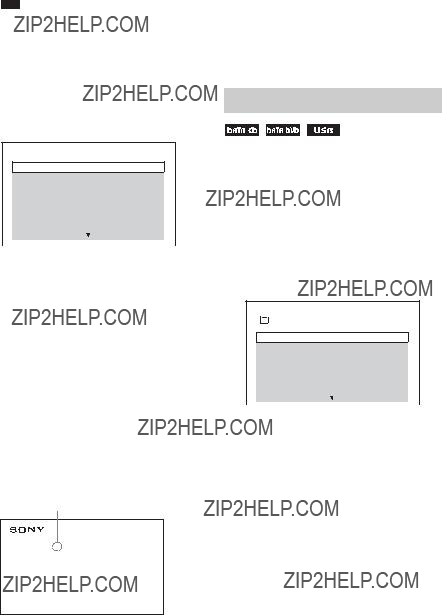
???It may take about 10 seconds before ???READING??? appears in the front panel display depending on the type of USB device.
[FOLDER LIST] appears on the TV screen. If [FOLDER LIST] does not appear, press
DVD MENU.
3 Press X/x to select a folder.
FOLDER LIST
01 Let's Talk About Love (1985)
02 1st Album (1986)
03 In the Middle of Nowhere (1986)
04 Ready for Romance (1986)
05 In the Garden of Venus (1987)
06 Romantic Warriors (1987)
07 Back for Good (1988)
08 Alone (1999)
4 Press N to start playback.
x For video or audio files
The system starts playback of files in the selected folder.
x For JPEG image files
The system starts a slide show of files in the selected folder.
5 Press VOLUME +/??? to adjust the volume.
To select the playback source of the USB device
You can select the memory number for playback depending on the USB device.
Press MEM SEL.
Selected memory number
USB Memory 2 selected.
Home Theatre System
Note
???When the memory cannot be selected, [Operation not possible.] appears on the TV screen.
???The memory number changes depending on the USB device.
To remove the USB device
1 Press x to stop playback.
2 Press [/1 to turn off the system.
3 Remove the USB device.
Playing a specific file
1 Select a folder by following Steps in ???Playing Files on a Disc/USB Device??? (page 33).
2 Press  to display the file list.
to display the file list.
3 Select a file.
To return to the folder list, press O
RETURN.
x For video or audio files
x For JPEG files
Press C/X/x/c to select an image.
4 Start playback.
x For video or audio files
Press N to start playback from the selected file.
x For JPEG image files
Press N to start a slide show beginning with the selected file. Press  to display only the selected file.
to display only the selected file.
34GB

To turn on/off the list of folders/ files
Press DVD MENU.
To display the list of folders/files using the Control Menu
3 Press X/x to select the desired list, then press  .
.
???[FOLDER LIST]: A list of folders appears. To display a list of files, press X/ x to select a folder, then press  .
.
???[PICTURE LIST] (JPEG image files only): A thumbnail list of the JPEG image files in the folder appears.
When different file types are on a disc/USB device
You can select the file type that is played with priority when mixed media (audio files, JPEG image files, or video files) are on the disc/USB device.
3 Press X/x to select a setting, then press  .
.
???[MUSIC/PHOTO] (DATA CD/DATA DVD only): You can play both JPEG image files and MP3 files in the same folder as a slide show.
???[MUSIC]: Audio file playback has priority.
???[VIDEO]: Video file playback has priority.
???[PHOTO]: JPEG image file playback has priority. You can play JPEG image files as a slide show.
The default setting differs depending on the source.
For details of the playback priority of file types under the [MEDIA] setting, see ???Playback Priority of File Types???
Other Playback
Operations
Playback operation buttons on the remote
Depending on the type of disc/file, the function may not work.
??? /m: fast reverse scan.
/m: fast reverse scan.
???M/ : fast forward scan.
: fast forward scan.
Each time you press  /m or M/
/m or M/ during scan, the scan speed changes.
during scan, the scan speed changes.
Playback
35GB

??? /m:
/m:
???M/ :
:
Each time you press  /m or M/
/m or M/ during
during
Rotate a JPEG X/x while viewing a JPEG image file image file.
Press CLEAR while holding down SHIFT to return to normal view.
???When playing files, you can select the next folder by continuing to press > (c for JPEG image files) after the last file on the current folder, but you cannot return to the previous folder by pressing .(C for JPEG image files). To return to the previous folder, select the folder from the folder list.
???You cannot rotate the JPEG image file when you set [JPEG RESOLUTION] in [HDMI SETUP] to [(1920 ?? 1080i) HD  ] or [(1920 ?? 1080i) HD] (page 63).
] or [(1920 ?? 1080i) HD] (page 63).
Playing a specific title/ chapter/track/scene, etc.
To select the title/chapter/track/ scene/index/folder/file number for playback
??? [TITLE/SCENE/TRACK]
[TITLE/SCENE/TRACK]
??? [CHAPTER/INDEX]
[CHAPTER/INDEX]
??? [TRACK]
[TRACK]
??? [INDEX]
[INDEX]
??? [FOLDER]
[FOLDER]
??? [FILE]
[FILE]
Example:  [CHAPTER]
[CHAPTER]
[** (**)] is selected (** refers to a number). The number in parentheses indicates the total number of titles, chapters, tracks, indexes, scenes, folders, or files.
98( 99)
13( 99)DVD VIDEO
 T 0: 03: 17
T 0: 03: 17
Selected row
Note
??? If [MEDIA] is set to [MUSIC/PHOTO] and
 [FILE] does not appear, press
[FILE] does not appear, press  DISPLAY again.
DISPLAY again.
3 Press X/x to select the desired number of the title, chapter, track, scene, etc., then press  .
.
You can also select the number by pressing the number buttons while holding down
SHIFT.
98( 99)

 13( 99)DVD VIDEO
13( 99)DVD VIDEO
T 0: 03: 17
If you make a mistake, press CLEAR while holding down SHIFT to cancel the number.
To select a scene using the time code
3 Input the time code using the number buttons while holding down SHIFT, then press  .
.
For example, to find a scene at 2 hours, 10 minutes, and 20 seconds after the beginning: press 2, 1, 0, 2, 0 ([2:10:20]) while holding down SHIFT.
36GB

Note
???You cannot search for a scene on a DVD+RW using the time code.
Changing angles
Press ANGLE during playback to select the desired angle.
Displaying subtitles
 *
*  *
*  *
*
*Except for United Kingdom and North American models.
Press SUBTITLE during playback to select the desired subtitle language.
Note
???You can select the subtitles if the DivX video file has an ???.avi??? or ???.divx??? extension and contains subtitle information within the same file (except for United Kingdom and North American models).
Changing the audio
Press AUDIO repeatedly during playback to select the sound.
x DVD VIDEO
You can toggle audio format or language when the source contains multiple audio formats or multilingual audio.
When 4 digits are displayed, they indicate a language code. See ???Language Code List??? (page 80) to confirm which language the code represents.
When the same language is displayed two or more times, the DVD VIDEO is recorded in multiple audio formats.
Example:
Dolby Digital 5.1 channel
x
You can toggle audio tracks when a disc contains multiple audio tracks.
x VIDEO CD/CD/DATA CD (MP3 file)/DATA
DVD (MP3 file)/USB device (audio file)
You can change the sound track.
???[STEREO]: The stereo sound.
???[1/L]: The sound of the left channel (monaural).
???[2/R]: The sound of the right channel (monaural).
xDATA CD (DivX video file)/DATA DVD (DivX video file)/USB device (DivX video file) (except for United Kingdom models)
You can toggle audio tracks when a video file contains multiple audio tracks.
xSuper VCD
You can change the sound track.
???[1:STEREO]: The stereo sound of audio track 1.
???[1:1/L]: The sound of the left channel of audio track 1 (monaural).
???[1:2/R]: The sound of the right channel of audio track 1 (monaural).
???[2:STEREO]: The stereo sound of audio track 2.
???[2:1/L]: The sound of the left channel of audio track 2 (monaural).
???[2:2/R]: The sound of the right channel of audio track 2 (monaural).
Playback
37GB

Using the DVD???s menu
When you play a DVD which contains several titles, you can select the title you want using
DVD TOP MENU.
When you play a DVD that allows you to select items such as the language for the subtitles and the language for the sound, select these items using DVD MENU.
1 Press DVD TOP MENU or DVD MENU.
2 Press C/X/x/c to select the item you want to play or change, then press  .
.
You can also select the number by pressing the number buttons while holding down
SHIFT.
To display the DVD???s menu on the Control Menu
3 Press X/x to select [MENU] or [TOP
MENU], then press  .
.
Selecting an original title or edited title on a
This function is only available for
1 Press  DISPLAY while the system is in stop mode.
DISPLAY while the system is in stop mode.
2 Press X/x to select  [ORIGINAL/
[ORIGINAL/
PLAY LIST], then press  .
.
3 Press X/x to select a setting, then press  .
.
???[PLAY LIST]: You can play the titles in the order of the existing playlist.
???[ORIGINAL]: You can play the titles as they were originally recorded.
Selecting a playback area for a Super Audio CD
Some Super Audio CDs consist of a 2 channel playback area and a
1 Press  DISPLAY while the system is in stop mode.
DISPLAY while the system is in stop mode.
2 Press X/x to select  [MULTI/ 2CH], then press
[MULTI/ 2CH], then press  .
.
3 Press X/x to select the setting, then press  .
.
???[MULTI]: You can play the
???[2CH]: You can play the 2 channel playback area.
Changing a playback layer for a hybrid Super Audio CD
Some Super Audio CDs consist of a Super Audio CD layer and a CD layer. You can change the playback layer you want to listen to.
1 Press  DISPLAY while the system is in stop mode.
DISPLAY while the system is in stop mode.
2 Press X/x to select  [SUPER
[SUPER
AUDIO CD/CD LAYER], then press  .
.
xWhen the current layer is the CD layer
[SUPER AUDIO CD] appears.
xWhen the current layer is the Super Audio CD layer
[CD] appears.
3 Press  to change the layer.
to change the layer.
???[SUPER AUDIO CD]: You can play the Super Audio CD layer.
When the system is playing a Super Audio CD layer,
38GB
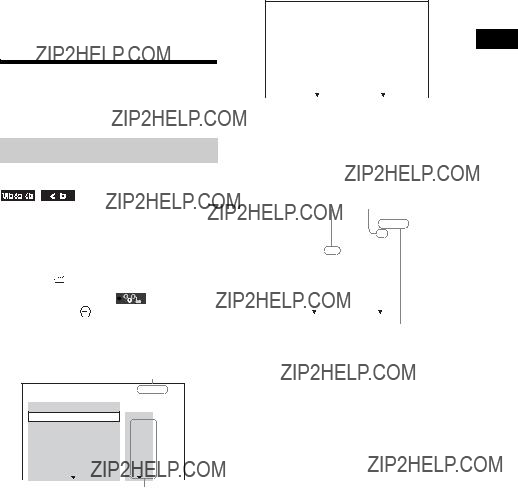
???[CD]: You can play the CD layer. When the system is playing a CD layer, ???CD??? lights up in the front panel display.
Note
???Super Audio CD audio signals are not output from the HDMI OUT jack.
Selecting the Playback
Mode
Playing in programmed order
(Program Play)
You can play the contents of a disc in the order you want by arranging the order of the tracks on the disc to create your own program. You can program up to 99 tracks.
3 Press X/x to select [SET t], then press  .
.
Total time of the programmed tracks
Tracks recorded on a disc
4 Press c.
The cursor moves to the track row [T] (in this case, [01]).
5 Select the track you want to program.
Ex. To set track 2 as the first programmed track
Press X/x to select [02] under [T], then press  .
.
Total time of the programmed tracks
6 To program other tracks, repeat Steps
4 to 5.
7 Press N to start Program Play.
To return to normal playback
Press CLEAR while holding down SHIFT when the display for the program setting is not displayed on the TV screen, or select [OFF] in Step 3. To play the same program again, select [ON] in Step 3 and press  .
.
To change or cancel a program
1 Follow Steps 1 to 3 of ???Playing in programmed order.???
2 Press X/x to select the program number of the track you want to change or cancel.
If you want to delete the track from the program, press CLEAR while holding down SHIFT.
Playback
39GB

3 Follow Step 5 of ???Playing in programmed order??? for new programming.
To cancel a program, select  .
.
To cancel all of the tracks in the programmed order
1 Follow Steps 1 to 3 of ???Playing in programmed order.???
2 Press X and select [ALL CLEAR], then press  .
.
Playing in random order
(Shuffle Play)
Note
???The same song may be played repeatedly when you are playing MP3 files.
1 Press  DISPLAY during playback.
DISPLAY during playback.
2 Press X/x to select  [SHUFFLE], then press
[SHUFFLE], then press  .
.
3 Press X/x to select the item to be shuffled.
x VIDEO CD/Super Audio CD/CD
???[OFF]: Off.
???[TRACK]: You can shuffle tracks on the disc.
x During Program Play
???[OFF]: Off.
???[ON]: You can shuffle tracks selected in Program Play.
x DATA CD (audio files only)/DATA
DVD (audio files only)/USB device (audio files only)
???[OFF]: Off.
???[ON (MUSIC)]: You can shuffle audio files in the folder on the current disc/USB device. When no folder is selected, the audio files in the first folder are shuffled.
4 Press  to start Shuffle Play.
to start Shuffle Play.
To return to normal playback
Press CLEAR while holding down SHIFT, or select [OFF] in Step 3.
???You cannot use Shuffle Play with a VIDEO CD or Super VCD with PBC playback.
Playing repeatedly
(Repeat Play)
1 Press  DISPLAY during playback.
DISPLAY during playback.
2 Press X/x to select  [REPEAT], then press
[REPEAT], then press  .
.
3 Press X/x to select the item to be repeated, then press  .
.
x DVD
???[OFF]: Off.
???[DISC]: You can repeat all of the titles on the disc.
???[TITLE]: You can repeat the current title on a disc.
???[CHAPTER]: You can repeat the current chapter on a disc.
x VIDEO CD/Super Audio CD/CD
???[OFF]: Off.
???[DISC]: You can repeat all of the tracks on the disc.
???[TRACK]: You can repeat the current track.
x DATA CD/DATA DVD/USB device
???[OFF]: Off.
???[DISC] (DATA CD/DATA DVD only): You can repeat all of the folders on the disc.
???[MEMORY] (USB device only): You can repeat all of the folders on the USB device.
???[FOLDER]: You can repeat the current folder.
???[TRACK] (audio files only): You can repeat the current file.
???[FILE] (video files only): You can repeat the current file.
40GB

4 Press N to start Repeat Play.
To return to normal playback
Press CLEAR while holding down SHIFT, or select [OFF] in Step 3.
Note
???You cannot use Repeat Play with a VIDEO CD or Super VCD with PBC playback.
Selecting an effect for the slide show
1 Press  DISPLAY repeatedly until
DISPLAY repeatedly until
 [EFFECT] appears on the control menu.
[EFFECT] appears on the control menu.
2 Press X/x to select  [EFFECT], then press
[EFFECT], then press  .
.
3 Press X/x to select a setting, then press  .
.
???[MODE 1]: The JPEG image file sweeps in from the top to the bottom of the TV screen.
???[MODE 2]: The JPEG image file stretches out from the left to the right of the TV screen.
???[MODE 3]: The JPEG image file stretches out from the center of the TV screen.
???[MODE 4]: The JPEG image files randomly cycle through the effects.
???[MODE 5]: The next JPEG image file slides over the previous image.
???[OFF]: Off.
Note
???The [EFFECT] setting is not effective when you set [JPEG RESOLUTION] in [HDMI SETUP] to [(1920 ?? 1080i) HD  ] or [(1920 ?? 1080i) HD] (page 63).
] or [(1920 ?? 1080i) HD] (page 63).
???The [EFFECT] setting cannot be selected when you are playing a disc that does not contain JPEG image files or a USB device, or when you set [MEDIA] to a setting that cannot play JPEG image files.
Selecting the slide show duration
1 Press  DISPLAY repeatedly until
DISPLAY repeatedly until
 [INTERVAL] appears on the control menu.
[INTERVAL] appears on the control menu.
2 Press X/x to select  [INTERVAL], then press
[INTERVAL], then press  .
.
3 Press X/x to select a setting, then press  .
.
???[NORMAL]: You can set to the standard duration.
???[FAST]: You can set the duration shorter than [NORMAL].
???[SLOW 1]: You can set the duration longer than [NORMAL].
???[SLOW 2]: You can set the duration longer than [SLOW 1].
Note
???Some JPEG image files may take longer to display than the option you selected, especially progressive JPEG image files or JPEG image files of 3,000,000 pixels or more.
???The [INTERVAL] setting cannot be selected when you are playing a disc that does not contain JPEG image files or a USB device, or when you set [MEDIA] to a setting that cannot play JPEG image files.
Playing a slide show with sound
1 Prepare a folder on a disc which contains both MP3 files and JPEG image files.
The MP3 files and JPEG image files must not be in separate folders. For details of making the disc, refer to the instructions of your PC, software, etc.
Playback
41GB

4 When [MUSIC/PHOTO] is selected, go to Step 5. When other than [MUSIC/ PHOTO] is selected, press X/x to select [MUSIC/PHOTO], then press  .
.
5 If the folder list does not appear, press
DVD MENU.
You can turn the folder list on/off by pressing DVD MENU repeatedly.
6 Press X/x to select the desired folder and press N.
???If you play a large MP3 file and JPEG image file at the same time, the sound may skip. Sony recommends that you set the MP3 bit rate to 128 kbps or lower when creating the file. If the sound still skips, reduce the size of the JPEG image file.
Displaying the
Information of a Disc/
USB Device
Viewing playback information
Press TIME/TEXT repeatedly during playback.
Information on the TV screen
1[T **:**:**/C **:**:**/D **:**:**]
Playing time of the current title, track/ chapter/disc
Remaining time of the current title, track/ chapter/disc
[**:**:**]
Playing time of the current scene/video file
2Bit rate
Appears when playing an audio file.
3File type
Appears when playing an audio/video file.
4Folder/file name
Appears when playing an audio file/JPEG image file/video file.
If an MP3 file has an ID3 tag, the system will display an album name/title name from the ID3 tag information.
The system can support ID3 ver 1.0/1.1/2.2/ 2.3.
ID3 ver 2.2/2.3 tag information display has priority when both ID3 ver 1.0/1.1 and ver 2.2/2.3 tags are used for a single MP3 file.
5Text information
The DVD/Super Audio CD/CD text appears only when text is recorded on the disc. You cannot change the text. If the disc does not contain text, ???NO TEXT??? appears.
Note
???Depending on the source being played, the system can only display a limited number of characters. Also, depending on the source, not all text characters will be displayed.
Information in the front panel display
Each time you press TIME/TEXT during playback, the following information appears. Some displayed items may disappear after a few seconds.
x DVD
1 Playing time of the current title
2 Remaining time of the current title
3 Playing time of the current chapter
4 Remaining time of the current chapter
5 Disc name
42GB
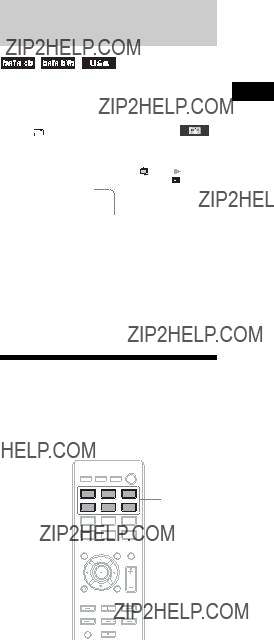
6 Title and chapter
xVIDEO CD (with PBC functions)/Super VCD (with PBC functions)
1 Playing time of the current item
2 Disc name
3 Scene number
xVIDEO CD (without PBC functions)/ Super Audio CD/CD
1 Playing time of the current track
2 Remaining time of the current track
3 Playing time of the disc
4 Remaining time of the disc
5 Track name
6 Track and index*
* VIDEO CD/Super Audio CD only.
xSuper VCD (without PBC functions)
1 Playing time of the current track
2 Track text
3 Track and index number
xDATA CD/DATA DVD/USB device (audio file)
1 Playing time and current track number
2 Track (file) name*
* If an MP3 file has an ID3 tag, the system will display a title name from the ID3 tag information. The system can support ID3 ver 1.0/1.1/2.2/2.3. ID3 ver 2.2/2.3 tag information display has priority when both ID3 ver 1.0/1.1 and ver 2.2/2.3 tags are used for a single MP3 file.
xDATA CD (video file)/DATA DVD (video file)/USB device (video file)
1 Playing time of the current file
2 Current file name
3 Current album and file number
Note
???The system can only display the first level of the DVD/CD text, such as the disc name or title.
???The disc name or track name may not be displayed depending on the text.
???Playing time of MP3 files and video files may not be displayed correctly.
Viewing the date information of a JPEG image file
You can check the date information during playback when the Exif* tag is recorded in the
*???Exchangeable Image File Format??? is a digital camera image format defined by the Japan Electronics and Information Technology Industries Association (JEITA).
Enjoying the Audio/Video
of the Connected
Component
Function selection buttons
43GB
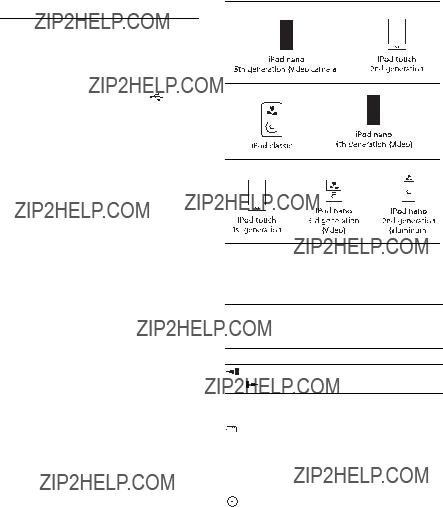
1 Use the function selection buttons to select the desired function.
The selected item appears in the front panel display.
You can also select the desired function by pressing FUNCTION repeatedly.
2 Prepare the source.
???DVD/CD: Insert the disc into the unit (page 33).
???TUNER FM: Select the radio program (page 46).
???USB: Connect the USB device directly (page 33), or iPod* via a USB cable (page 44).
???TV: Select the channel on the TV or set- top box.
???AUDIO IN: Connect the portable audio source via an audio cord (stereo
3 Operate the connected component.
To enjoy a
* United Kingdom models only.
iPod models that can be operated via USB
You can operate an iPod using the buttons on the remote by connecting the iPod via the  (USB) port to the system.
(USB) port to the system.
The battery of the iPod is charged via the system.
The iPod models that can be operated via USB are as follows. Update your iPod with the latest software before using it with the system.
Remote buttons for operating an iPod connected to the system are as follows:
xPause.
. or > Same operation as the . or >
Note
???The iPod is charged when connected to the system while the system is turned on.
???You cannot transfer songs onto the iPod.
???Sony cannot accept responsibility in the event that data recorded to iPod is lost or damaged when using an iPod connected to this unit.
44GB

???This product has been designed specifically to work with iPod and has been certified to meet Apple performance standards.
Playback
45GB

Tuner
Presetting Radio
Stations
You can preset 20 FM stations.
Current station
Current band and preset number
FM
FM 10 : 88.00 MHz
SONY RADIO
Station name
1 Press FM.
2 Press and hold TUNING +/??? until the auto scanning starts.
Scanning stops when the system tunes in a station. ???TUNED??? appears in the front panel display. When a stereo program is received, ???ST??? also appears in the front panel display.
3 Press SYSTEM MENU.
4 Press X/x to select ???MEMORY.???
5 Press  or c.
or c.
A preset number appears in the front panel display.
6 Press X/x to select the preset number you want.
7 Press  .
.
???COMPLETE??? appears in the front panel display, and the station is stored.
8 Repeat Steps 2 to 7 to store other stations.
9 Press SYSTEM MENU.
To change the preset number
Select the desired preset number by pressing PRESET +/??? (page 46), then perform the procedure from Step 3.
Listening to the Radio
Preset radio stations in the system???s memory first (see ???Presetting Radio Stations??? (page 46)).
1
2 Press PRESET +/??? repeatedly to select the preset station.
3 Adjust the volume by pressing VOLUME
To listen to radio stations when you know the frequencies
Press D.TUNING in Step 2, press the number buttons while holding down SHIFT to select the frequencies, then press  .
.
To listen to
Use manual or automatic tuning in Step 2. For manual tuning, press TUNING +/??? repeatedly.
For automatic tuning, press and hold TUNING
If an FM program is noisy
If an FM program is noisy, you can select monaural reception. There will be no stereo effect, but reception will improve.
1 Press SYSTEM MENU.
2 Press X/x to select ???FM MODE.???
3 Press  or c.
or c.
4 Press X/x to select ???MONO.???
??????STEREO???: Stereo reception.
??????MONO???: Monaural reception.
46GB

Viewing the station name or frequency in the front panel display
You can check the station name or frequency using the front panel display.
Press TIME/TEXT.
Each time you press TIME/TEXT, the display changes as follows.
When the station name is received via the RDS function
1 Station name
Ex. ???SONY RADIO??? 2 Frequency
Ex. ???FM1 87.50???
3 The ???FM MODE??? setting Ex. ???STEREO???
When the station name is not set
1 Frequency
Ex. ???FM1 87.50???
2 The ???FM MODE??? setting Ex. ???STEREO???
Using the Radio Data
System (RDS)
What is the Radio Data
System?
The Radio Data System (RDS) is a broadcasting service that allows radio stations to send additional information along with the regular program signal. This tuner offers convenient RDS features, such as station name display.
Receiving RDS broadcasts
Simply select a station.
When you tune in a station that provides RDS services, the station name* appears in the front panel display.
*If an RDS broadcast is not received, the station name does not appear in the front panel display.
Note
???Not all FM stations provide RDS service, nor do they provide the same type of services. If you are not familiar with RDS services, check with your local radio stations for details and availability in your area.
Tuner
47GB

Sound Effect
Enjoying Surround Sound
You can enjoy surround sound simply by selecting one of the system???s
Enjoying TV sound with the 5.1 channel surround sound effect
1
2
3
4
Press SYSTEM MENU.
Press X/x to select ???SUR.SETTING,??? then press  or c.
or c.
The selected item appears in the front panel display.
Press X/x to select ???PRO LOGIC,??? then press  .
.
Press SYSTEM MENU.
Note
??? When TV program sound is monaural, sound is output only from the center speaker.
Selecting surround settings based on your listening preference
1
2
3
Press SYSTEM MENU.
Press X/x to select ???SUR.SETTING,??? then press  or c.
or c.
The selected item appears in the front panel display.
Press X/x to select the surround setting you want, then press  .
.
See the table below for surround setting descriptions.
4 Press SYSTEM MENU.
About speaker output
The table below describes the options when you connect all the speakers to the unit and you set [SPEAKER FORMATION] to [STANDARD] (page 65).
???A.F.D. MULTI???
(AUTO FORMAT
DIRECT MULTI)
???2 channel source: The system outputs 2 channel sound from the front and surround speakers by assigning the 2 channel sound to the surround left and right channels.
???
48GB

??????PLII MUSIC??? performs Dolby Pro Logic II music mode decoding.
???
Note
???You cannot select the surround settings while the system is loading a disc.
???Depending on the input stream, the surround settings may not be effective.
Effect Sound
49GB

Selecting the Sound
Effect
Selecting the effect to suit the source
Press SOUND MODE repeatedly during playback until the desired mode appears in the front panel display.
??????AUTO???: The system automatically selects ???MOVIE??? or ???MUSIC??? to produce the sound effect depending on the source. ???AUTO??? appears in the front panel display.
??????MOVIE???: The system provides the sound for movies. ???MOVIE??? appears in the front panel display.
??????MUSIC???: The system provides the sound for music. ???MUSIC??? appears in the front panel display.
Note
???When you play a Super Audio CD, this function does not work.
Enhancing compressed sound
You can enhance compressed sound such as an MP3 file.
This effect is activated automatically when all the following conditions are satisfied:
???The function is set to ???AUDIO IN??? or ???USB.???
??????SUR.SETTING??? is set to ???A.F.D. STD??? or ???A.F.D. MULTI??? (page 48).
To turn off the sound effect
Select other than ???A.F.D. STD??? or ???A.F.D. MULTI??? for ???SUR.SETTING??? (page 48).
50GB

Convenient Functions
Using the Control for HDMI Function for ???BRAVIA??? Sync
This function is available on TVs with the ???BRAVIA??? Sync function.
By connecting Sony components that are compatible with the Control for HDMI function with an HDMI cable, operation is simplified as below:
???System Power Off (page 51)
???
???Theatre Mode (page 52)
???System Audio Control (page 52)
???Volume Limit (page 52)
???Audio Return Channel (page 52)
???Remote Easy Control (page 52)
???Language Follow (page 53)
Control for HDMI is a mutual control function standard used by CEC (Consumer Electronics Control) for HDMI
Note
???Depending on the connected component, the Control for HDMI function may not work. Refer to the operating instructions of the component.
Preparing the Control for HDMI function
(Control for HDMI - Easy Setting)
If your TV is compatible with the Control for HDMI - Easy Setting function, you can set the system???s [CONTROL FOR HDMI] function automatically by setting your TV. For details, refer to the operating instructions of your TV.
If your TV is not compatible with the Control for HDMI - Easy Setting function, set the Control for HDMI function of the system and TV manually.
1 Make sure that the system and your TV are connected with an HDMI cable.
2 Turn on your TV and press [/1 to turn on the system.
3
4 Set the Control for HDMI function of your TV.
For details of the setting of your TV, refer to the operating instructions of your TV.
5 On the system, press DVD/CD.
6 Press  DISPLAY while the system is in stop mode.
DISPLAY while the system is in stop mode.
7 Press X/x to select  [SETUP], then press
[SETUP], then press  .
.
8 Press X/x to select [CUSTOM], then press  .
.
9 Press X/x to select [HDMI SETUP], then press  .
.
10 Press X/x to select [CONTROL FOR
HDMI], then press  .
.
11 Press X/x to select [ON], then press
 .
.
Turning the system off in sync with your TV
(System Power Off)
When you turn your TV off by using the POWER button on your TV???s remote or TV [/1 on the system???s remote, the system turns off automatically.
Note
???This function depends on the settings of your TV. For details, refer to the operating instructions of your TV.
???Depending on the status of the system (ex. while playing a CD), the system may not turn off automatically.
Functions Convenient
51GB

Watching a DVD by a single button press
Press
Your TV turns on, your TV???s function is set to the HDMI input to which the system is connected, and the system starts playing a disc automatically.
The System Audio Control function is also activated automatically.
Using the Theatre Mode
(Theatre Mode)
If your TV is compatible with the Theatre Mode, you can enjoy optimal image and sound quality suited for movies, and the System Audio Control function is activated automatically.
Press THEATRE.
Enjoying TV sound from the speakers by this system
(System Audio Control)
To use this function, connect the system and your TV with a SCART (EURO AV) cable and an HDMI cable (page 26).
Press [/1 to turn on the system while your
TV is turned on.
The System Audio Control function is activated. TV sound is output from the system speakers, and the volume of your TV???s speakers is minimized automatically.
Note
???While your TV is in PAP (picture and picture) mode, the System Audio Control function will not work. When your TV exits PAP mode, the output method of your TV returns to the one before PAP mode.
???When you turn the system on by pressing the function selection button, video and sound may not match.
???Depending on the TV, when you adjust the system???s volume, the volume level appears on the TV screen. In this case, the volume levels that appear on the TV
screen and the front panel display of the system may differ.
???You can also operate the System Audio Control function via the TV menu.
???You can operate the volume and mute control of the system via the TV remote.
Limiting the volume level of TV sound from the system???s speakers
(Volume Limit)
When the System Audio Control function is activated and TV sound is output from the system???s speakers, the volume level is limited to the level that is set in [VOLUME LIMIT]. For details, see [VOLUME LIMIT] (page 64).
Receiving the digital audio signal of your TV
(Audio Return Channel)
The system can receive the digital audio signal of your TV via an HDMI cable when your TV is compatible with the Audio Return Channel function. You can enjoy TV sound via the system by using just one HDMI cable. For details, see [AUDIO RETURN CHANNEL] (page 64).
Operating the system via the TV remote
(Remote Easy Control)
You can control the basic functions of the system via the TV remote when the system???s video output is displayed on the TV screen. For details, refer to the operating instructions of the TV.
52GB

Changing the language for the system???s
(Language Follow)
When you change the language for the
Note
???When the system???s
Using an
When you purchase the
About
There are two types of
???
???
???Surround amplifier (optional): You can enjoy surround speaker sound wirelessly.
???
Room B
Inserting the wireless transmitter/transceiver
To make use of the
Note
???When you insert the wireless transmitter/transceiver, make sure that the AC power cord (mains lead) is not connected to a wall outlet (mains).
???Do not touch the terminals of the wireless transmitter/ transceiver.
To insert the wireless transmitter into the unit
1 Remove the screws directly below the  mark.
mark.
Rear of the unit
Functions Convenient
53GB

???Remove the screws that are indicated in the illustration. Do not remove other screws.
2 Insert the wireless transmitter.
Rear of the unit
???Insert the wireless transmitter with the
???Insert the wireless transmitter so that the V marks are aligned.
???Do not insert anything other than the wireless transmitter into the
3 Make sure to use the same screws to secure the wireless transmitter.
Rear of the unit
To insert the wireless transceiver into the
For details on installing the wireless transceiver into the
54GB
Tip
???When you change the
Setting the
For the surround amplifier
For the
Simply by matching the ID of the main unit and the
To set the ID of the unit
1 Press SYSTEM MENU.
2 Press X/x to select  or c.
or c.
The selected item appears in the front panel display.
3 Press X/x to select the desired ID, then press  .
.
You can select any ID (A, B, or C).
4 Press SYSTEM MENU.
5 Set the
Wireless transmission is activated as follows (example):
???To confirm the current ID, perform Steps 1 to 3 above. When you pair the unit with an

Enjoying sound by the
For the
You can receive the system???s sound by the
1 Press SYSTEM MENU.
2 Press X/x to select  or c.
or c.
The selected item appears in the front panel display.
3 Press X/x to select the desired setting, then press  .
.
??????STBY ON???: You can receive the system???s sound by the
??????STBY OFF???: You cannot receive the system???s sound by the
4 Press SYSTEM MENU.
Note
???When you turn the system off while
Identifying the unit with a specific
For the surround amplifier
For the
When using
Functions Convenient
55GB

When you perform pairing, wireless transmission is activated between the paired main unit and
1 Place the
2 Match the IDs of the unit and the
???To set the ID of the unit, see ???To set the ID of the unit??? (page 54).
???To set the ID of the surround amplifier, refer to the operating instructions of the surround amplifier.
???To set the ID of the
3 Press SYSTEM MENU.
4 Press X/x to select ???PAIRING,??? then press  or c.
or c.
The selected item appears in the front panel display.
5 After ???START??? appears in the front panel display, press  .
.
The unit starts pairing and ???SEARCH??? flashes in the front panel display.
To cancel pairing, press SYSTEM MENU.
6 Start pairing of the
x For the surround amplifier
Press "/1 on the surround amplifier to turn on the surround amplifier and press PAIRING on the rear panel of the surround amplifier. (To press PAIRING, a slim instrument, such as a paper clip, can be used.)
The PAIRING indicator of the surround amplifier flashes when pairing starts. When wireless transmission is activated, the PAIRING indicator of the surround amplifier turns on and ???PAIRING??? and ???COMPLETE??? appear alternately in the front panel display.
x For the
Refer to the operating instructions of the
When wireless transmission is activated, ???PAIRING??? and ???COMPLETE??? appear alternately in the front panel display.
???Perform pairing within several minutes of Step 5. If you do not do so, ???PAIRING??? and ???INCOMPLETE??? appear alternately in the front
panel display. To continue pairing, press  and start again from Step 5. To cancel pairing, press
and start again from Step 5. To cancel pairing, press
SYSTEM MENU.
7 Press SYSTEM MENU.
To cancel pairing
Change the ID of the main and sub unit (page 54).
If wireless transmission is unstable
For the surround amplifier
For the
If you use multiple wireless systems, such as wireless LAN or Bluetooth, the transmission of
1 Press SYSTEM MENU.
2 Press X/x to select ???RF CHANGE,??? then press  or c.
or c.
The selected item appears in the front panel display.
3 Press X/x to select the desired setting, then press  .
.
??????AUTO???: Normally select this. The system changes ???RF CHANGE??? to ???ON??? or ???OFF??? automatically.
??????ON???: The system transmits sound by searching for the better channel for transmitting.
??????OFF???: The system transmits sound by fixing the channel for transmitting.
4 Press SYSTEM MENU.
5 When you set ???RF CHANGE??? to ???OFF,??? select the ID so that wireless transmission is most stable (page 54).
56GB

Note
???In most cases, you will not need to change this setting.
???If ???RF CHANGE??? is set to ???OFF,??? transmission between the unit and
???
???
???
???The transmission may be improved by changing the transmission channel (frequency) of the other wireless system(s). For details, refer to the operating instructions of the other wireless system(s).
Transferring Songs onto a USB Device
You can transfer songs on an audio CD onto a USB device by encoding to MP3 format. You can also transfer MP3 files on a DATA CD/ DATA DVD onto a USB device.
For connecting the USB device, see ???Playing Files on a Disc/USB Device??? (page 33).
The transferred music is limited to private use only. Use of the music beyond this limit requires permission of the copyright holders.
Notes on USB transferring
???Do not connect the unit and the USB device through a USB hub.
???Make sure there is enough space in the USB device for transferring.
???Do not remove the USB device during transferring.
???When you are transferring tracks from an audio CD, the tracks are recorded as 128 kbps MP3 files.
???When you are transferring MP3 files from a DATA CD/DATA DVD, the MP3 files are transferred with the same bit rate as the original MP3 files.
???CD text information is not transferred in the created MP3 files.
depending on the USB device.
Press MEM SEL.
Selected memory number
USB Memory 2 selected.
Home Theatre System
Note
???When the memory cannot be selected, [Operation not possible.] appears on the TV screen.
???The memory number changes depending on the USB device.
???Select a transfer destination before transfer.
Folder and file generation rules
When transferring onto a USB device, a ???MUSIC??? folder is created directly below the ???ROOT???. Folders and files are generated within this ???MUSIC??? folder as follows according to the transferring method and source.
57GB
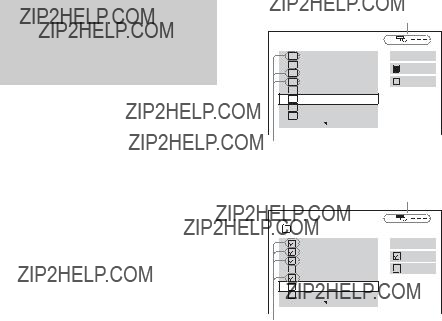
??? When transferring multiple tracks on an audio CD or multiple MP3 files on a DATA CD/
DATA DVD
??? When transferring a single track on an audio CD or a single MP3 file on a DATA CD/
DATA DVD
1)Up to 64 characters of the name are assigned (including the extension).
2)Folders are assigned in numeric order thereafter.
3)Files are assigned in numeric order thereafter.
4)A new file is transferred in the
Transferring tracks on an audio CD or MP3 files on a DATA CD/DATA DVD onto a USB device
1 Load an audio CD/DATA CD/DATA DVD.
2 Press  DISPLAY while the system is in stop mode.
DISPLAY while the system is in stop mode.
3 Press X/x to select  [USB
[USB
TRANSFER], then press  .
.
x For an audio CD
Press  and skip to Step 5.
and skip to Step 5.
x For a DATA CD/DATA DVD
Follow the next Step.
4 Press X/x to select [TRACK] or [FOLDER], then press  .
.
???[TRACK]: The folder list appears. Press X/x to select the desired folder, then press  .
.
???[FOLDER]: The folders recorded on the DATA CD/DATA DVD appear. You can transfer all MP3 files in the folder.
5 Press C/X/x/c to select [x ALL] (for an audio CD) or [ ALL] (for a DATA CD/ DATA DVD), then press
ALL] (for a DATA CD/ DATA DVD), then press  .
.
To deselect all tracks, select [s ALL], then press  .
.
6 Press C/X/x/c to select [START], then press  .
.
To cancel transferring, press x.
To select individual tracks/MP3 files/folders
Press X/x to highlight the track/MP3 file/folder, then press  to add a check in Step 5.
to add a check in Step 5.
To cancel the selection, highlight the track/MP3 file/folder, then press  to remove the check.
to remove the check.
x For an audio CD
Remaining space of the USB device
Tracks to be transferred.
x For a DATA CD/DATA DVD
Remaining space of the USB device
MP3 files/folders to be transferred.
58GB

Transferring by single button press
You can transfer tracks/MP3 files simply onto a USB device by using REC TO USB.
1 Load an audio CD/DATA CD/DATA DVD.
2 Press x.
To transfer all tracks, skip to Step 4.
To transfer a single track, follow the next Step.
3 Select the desired track/MP3 file, then press N.
4 Press REC TO USB on the unit.
REC TO USB lights up and ???READING??? appears in the front panel display. Then, ???PUSH PLAY??? and the remaining space of the USB device appear alternately in the front panel display.
5 Press N to start transferring.
When transferring is completed, ???COMPLETE??? appears in the front panel display and playback of the disc and USB device stops automatically.
To cancel transferring, press x.
To cancel, select [NO], then press  .
.
Note
???Do not remove the USB device while erasing.
???If the folder to be erased contains
Using the sleep timer
You can set the system to turn off at a preset time, so you can fall asleep listening to music.
1 Press SYSTEM MENU.
2 Press X/x to select ???SLEEP,??? then press  or c.
or c.
The selected item appears in the front panel display.
3 Press X/x to select a setting, then press  .
.
The minutes display (the remaining time) changes by 10 minutes.
4 Press SYSTEM MENU.
Functions Convenient
Erasing audio files on a USB device
You can erase audio files (???.mp3,??? ???.wma,??? or ???.m4a???) on the USB device.
1 Press USB.
2 Press X/x to select a folder.
3 Select the audio file(s).
xTo erase all audio files in a folder
Press CLEAR while holding down SHIFT.
xTo erase an audio file
Press  and press X/x to select the desired audio file, then press CLEAR while holding down SHIFT.
and press X/x to select the desired audio file, then press CLEAR while holding down SHIFT.
4 Press C/c to select [YES], then press
 .
.
Adjusting the Delay
Between the Picture and
Sound
[A/V SYNC]
When the sound does not match the pictures on the TV screen, you can adjust the delay between the picture and sound.
3 Press X/x to select a setting, then press  .
.
59GB

???[OFF]: Off.
???[ON]: You can adjust the delay between the picture and sound.
???Depending on the input stream, [A/V SYNC] may not be effective.
Enjoying Multiplex
Broadcast Sound
(DUAL MONO)
You can enjoy multiplex broadcast sound when the system receives or plays a Dolby Digital multiplex broadcast signal.
Note
???To receive a Dolby Digital signal, you need to connect a TV or other component to the unit with an digital optical cord (page 26). If your TV is compatible with the Audio Return Channel function (page 52), you can receive a Dolby Digital signal via an HDMI cable.
Press AUDIO repeatedly to select the audio signal.
The selected item appears in the front panel display.
??????MAIN???: Sound of the main language will be output.
??????SUB???: Sound of the sub language will be output.
??????MAIN+SUB???: Mixed sound of both the main and sub languages will be output.
Changing the Input Level of the Sound from Connected Components
The sound distortion of the connected component may be improved by reducing the input level.
1 Press TV or AUDIO IN.
2 Press SYSTEM MENU.
3 Press X/x to select ???ATTENUATE,??? then press  or c.
or c.
4 Press X/x to select a setting, then press  .
.
??????ATT ON???: You can attenuate the input level.
??????ATT OFF???: Normal input level.
This setting is made separately for each function.
5 Press SYSTEM MENU.
60GB

Settings
Changing the Brightness
of the Front Panel
Display
1 Press SYSTEM MENU.
2 Press X/x to select ???DIMMER,??? then press  or c.
or c.
The selected item appears in the front panel display.
3 Press X/x to select the brightness of the front panel display, then press  .
.
??????DIMMER OFF???: The front panel display is bright.
??????DIMMER ON???: The front panel display is dim.
4 Press SYSTEM MENU.
Setting the Demonstration Mode to On/Off
You can turn on/off the demonstration in the front panel display while the system is in standby mode.
1 Press SYSTEM MENU.
2 Press X/x to select ???DEMO,??? then press  or c.
or c.
The selected item appears in the front panel display.
3 Press X/x to select a setting, then press  .
.
??????DEMO OFF???: Off.
??????DEMO ON???: On.
4 Press SYSTEM MENU.
Reperforming the Quick
Setup
1 Press DVD/CD.
2 Press  DISPLAY while the system is in stop mode.
DISPLAY while the system is in stop mode.
3 Press X/x to select  [SETUP], then press
[SETUP], then press  .
.
4 Press X/x to select [QUICK], then press
 .
.
Perform the Quick Setup following the procedure of ???Performing the Quick Setup??? (page 30).
Set the System to
Standby Mode
Automatically
The system enters standby mode automatically when you do not operate the system for about 30 minutes and the system is not outputting sound for about 30 minutes. ???AUTO STBY??? begins to flash in the front panel display about 2 minutes before the system enters standby mode.
You can turn the auto standby function on/off.
1 Press SYSTEM MENU.
2 Press X/x to select ???AUTO STBY,??? then press  or c.
or c.
The selected item appears in the front panel display.
3 Press X/x to select the setting, then press  .
.
??????ON???: On.
??????OFF???: Off.
4 Press SYSTEM MENU.
Settings
61GB

Performing Further
Settings
You can make various adjustments to items such as picture and sound.
Displayed items vary depending on the area.
Note
???Playback settings stored in the disc take priority over the Setup Display settings and not all the functions described may work.
1 Press DVD/CD.
2 Press  DISPLAY while the system is in stop mode.
DISPLAY while the system is in stop mode.
3 Press X/x to select  [SETUP], then press
[SETUP], then press  .
.
4 Press X/x to select [CUSTOM], then press  .
.
5 Press X/x to select the setup item, then press  .
.
???[LANGUAGE SETUP] (page 62)
???[VIDEO SETUP] (page 63)
???[HDMI SETUP] (page 63)
???[AUDIO SETUP] (page 65)
???[SYSTEM SETUP] (page 66)
???[SPEAKER SETUP] (page 67)
Example: [VIDEO SETUP]
Selected item
VIDEO SETUP
Setup items
6 Press X/x to select an item, then press
 .
.
The options for the selected item appear. Example: [TV TYPE]
VIDEO SETUP
7 Press X/x to select a setting, then press  .
.
The setting is selected and setup is complete.
Example: [4:3 LETTER BOX]
VIDEO SETUP
Selected setting
To reset all of the [SETUP] settings
To reset all of the [SETUP] settings, see [RESET] (page 67).
Setting the display or sound track language
 [LANGUAGE SETUP]
[LANGUAGE SETUP]
Set various languages for the
x [OSD]
You can switch the display language on the TV screen.
x [MENU] 
You can switch the language for the disc???s menu.
62GB

x [AUDIO] 
You can switch the language of the sound track. When you select [ORIGINAL], the language given priority on the disc is selected.
x [SUBTITLE] 
You can switch the language of the subtitles recorded on the DVD VIDEO.
When you select [AUDIO FOLLOW], the language for the subtitles changes according to the language you selected for the sound track.
Note
???When you select a language in [MENU], [AUDIO], or [SUBTITLE] that is not recorded on the DVD VIDEO, one of the recorded languages will be automatically selected (depending on the disc, the language may not be selected automatically).
Tip
???If you select [OTHERS t] in [MENU], [AUDIO], and [SUBTITLE], select and enter a language code from ???Language Code List??? (page 80) using the number buttons.
Settings for the display
 [VIDEO SETUP]
[VIDEO SETUP]
Select settings according to your TV.
x [TV TYPE]
You can select the aspect ratio of the connected TV.
[16:9]: Select this when you connect a wide- screen TV or a TV with a
[4:3 LETTER BOX]: Select this when you connect a 4:3 standard TV. The system displays a wide picture with bands on the upper and lower portions of the TV screen.
[4:3 PAN SCAN]: Select this when you connect a 4:3 standard TV. The system automatically displays a wide picture on the entire screen and cuts off the portions that do not fit.
x [LINE]
You can select the output method for video signals from the EURO AV TOUTPUT (TO TV) jack.
[VIDEO]: The system outputs video signals.
[RGB]: The system outputs RGB signals.
Note
???If your TV does not accept RGB signals, no picture appears on the TV screen even if you select [RGB]. Refer to the operating instructions of your TV.
???You cannot select [RGB] while ???HDMI??? is lit. [RGB] automatically switches to [VIDEO] when you turn on any connected HDMI equipment.
x [PAUSE MODE] 
(DVD
You can select the picture in pause mode.
[AUTO]: The picture, including subjects that move dynamically, is output with no jitter. This setting is for normal usage.
[FRAME]: The picture, including subjects that do not move dynamically, is output in high resolution.
Settings for HDMI
 [HDMI SETUP]
[HDMI SETUP]
x [HDMI RESOLUTION]
You can select the type of video signal that is output from the HDMI OUT jack.
[AUTO (1920 ?? 1080p)]: The system outputs the optimal video signal for the connected TV. [1920 ?? 1080i]: The system outputs 1920 ?? 1080i* video signals.
Settings
63GB

[1280 ?? 720p]: The system outputs 1280 ??
720p* video signals.
[720 ?? 480p]**: The system outputs 720 ??
480p* video signals.
*i: interlace, p: progressive
**Depending on the area, [720 ?? 480/576p] may appear.
x [CONTROL FOR HDMI]
This function is available when you connect the system and TV that is compatible with the Control for HDMI function with an HDMI cable.
[OFF]: Off.
[ON]: On. You can operate mutually between components that are connected with an HDMI cable.
x [VOLUME LIMIT]
When the System Audio Control (page 52) is activated, loud sound may be output depending on the volume level of the system. You can prevent this by limiting the maximum level of the volume when the System Audio Control function activates.
[OFF]: Off.
[LEVEL3]: Maximum volume level is set to 10.
[LEVEL2]: Maximum volume level is set to 15.
[LEVEL1]: Maximum volume level is set to 20.
Note
???This function is available only when [CONTROL FOR HDMI] is set to [ON].
x [AUDIO RETURN CHANNEL]
This function is available when you connect the system and TV that is compatible with the Audio Return Channel function.
[AUTO]: The system can receive the digital audio signal of your TV via an HDMI cable automatically.
[Off]: Off.
Note
???This function is available only when [CONTROL FOR HDMI] is set to [ON].
x [YCBCR/RGB (HDMI)]
You can select the type of HDMI signal output from the HDMI OUT jack.
[YCBCR]: The system outputs YCBCR signals.
[RGB]: The system outputs RGB signals.
x [AUDIO (HDMI)]
You can select the audio output status from the HDMI OUT jack.
[OFF]: The system does not output sound from the HDMI OUT jack.
[ON]: The system outputs audio signals by converting Dolby Digital, DTS, or 96 kHz/24- bit PCM signals to 48
???When you set the function to other than ???DVD/CD??? or ???USB,??? the system does not output the sound from the HDMI OUT jack even if you set [AUDIO (HDMI)] to [ON].
x [JPEG RESOLUTION]
You can select the resolution of JPEG image files output from the HDMI OUT jack.
[SD  ]: The system outputs standard resolution with a black frame.
]: The system outputs standard resolution with a black frame.
[HD  ]: The system outputs HD resolution with a black frame.
]: The system outputs HD resolution with a black frame.
[HD]: The system outputs the HD resolution without a black frame.
[(1920 ?? 1080i) HD  ]: The system outputs full size HD resolution with a black frame. [(1920 ?? 1080i) HD]: The system outputs full size HD resolution without a black frame.
]: The system outputs full size HD resolution with a black frame. [(1920 ?? 1080i) HD]: The system outputs full size HD resolution without a black frame.
???[JPEG RESOLUTION] is effective only when you set [TV TYPE] in [VIDEO SETUP] to [16:9], and you set [HDMI RESOLUTION] in [HDMI SETUP] to other than [720 ?? 480p] or [720 ?? 480/576p].
???You can select [(1920 ?? 1080i) HD  ] or [(1920 ?? 1080i) HD] only when you set [HDMI RESOLUTION] in [HDMI SETUP] to [1920 ?? 1080i].
] or [(1920 ?? 1080i) HD] only when you set [HDMI RESOLUTION] in [HDMI SETUP] to [1920 ?? 1080i].
???The HDMI signal will stop momentarily when:
???the system is loading or unloading a DATA CD or
DATA DVD.
???you connect or remove a USB device.
64GB

Settings for the audio
 [AUDIO SETUP]
[AUDIO SETUP]
x [SPEAKER FORMATION]
Depending on the shape of the room, you may not be able to install some speakers. For better surround sound, Sony recommends that first you decide the position of the speakers.
1 Press C/c to select a setting, then press  .
.
???[STANDARD]: Select this when you install all the speakers normally.
???[NO CENTER]: Select this when you install the front and surround speakers only.
???[NO SURROUND]: Select this when you install the center and front speakers only.
???[FRONT ONLY]: Select this when you install the front speakers only.
???[ALL FRONT]: Select this when you install all the speakers in front of the listening position.
???[ALL FRONT - NO CENTER]: Select this when you install the front and surround speakers in front of the listening position.
2 Press C/c to select [YES] or [NO], then press  .
.
???[YES]: Continue with [AUTO CALIBRATION]. Follow the Steps of [AUTO CALIBRATION] below.
???[NO]: Exit [SPEAKER FORMATION].
x [AUTO CALIBRATION]
D. C. A. C. (Digital Cinema Auto Calibration) can set the appropriate surround sound automatically.
1 Connect the calibration mic (supplied) to the A.CAL MIC jack on the front panel.
Set up the calibration mic at ear level using a tripod, etc. (not supplied).
The front of each speaker should face the calibration mic, and there should be no
obstruction between the speakers and the calibration mic.
Calibration mic
Settings
2 Press C/c to select [YES], then press
 .
.
[AUTO CALIBRATION] starts. Be quiet during the measurement.
Note
???The environment of the room in which the system is installed may affect measurements. When the measurements differ considerably from the status of the speaker installation, perform the speaker settings manually by following ???Settings for the speakers??? (page 67).
3 Press C/c to select [YES] or [NO], then press  .
.
4 Disconnect the calibration mic when the measurement completes correctly.
Note
???The system outputs a loud test sound when [AUTO CALIBRATION] starts. You cannot turn the volume down. Give consideration to children and neighbors.
???The measurement for [SUBWOOFER] is always [YES] and [SPEAKER SETUP] returns to the default setting when you perform [AUTO CALIBRATION].
65GB

x [AUDIO DRC] 
You can compress the dynamic range of the sound track. [AUDIO DRC] is useful for watching movies at low volume late at night.
[OFF]: No compression of dynamic range.
[STANDARD]: The system reproduces the sound track with the kind of dynamic range that the recording engineer intended.
[MAX]: The system compresses dynamic range fully.
Note
??? [AUDIO DRC] works only for Dolby Digital.
x [TRACK SELECTION] 
You can give the sound track which contains the highest number of channels priority when multiple audio formats (PCM, DTS, Dolby Digital, or MPEG audio) are recorded.
[OFF]: Off.
[AUTO]: The system selects the sound track automatically according to the priority.
???When you set the item to [AUTO], the language may change. The [TRACK SELECTION] setting has higher priority than the [AUDIO] settings in [LANGUAGE SETUP] (page 62). (Depending on the disc, this function may not work.)
Other Settings
 [SYSTEM SETUP]
[SYSTEM SETUP]
x [SCREEN SAVER]
You can reduce the damage to the display device (ghosting). Press any button (e.g., N) to cancel the screen saver.
[ON]: The screen saver image appears if you do not operate the system for about 15 minutes. [OFF]: Off.
x [BACKGROUND]
You can select the background color or picture on the TV screen.
[JACKET PICTURE]: The jacket picture (still picture) appears, but only when the jacket picture is already recorded on the disc (CD- EXTRA, etc.). If the disc does not contain a jacket picture, a preset picture stored in the system appears.
[GRAPHICS]: A preset picture stored in the system appears.
[BLUE]: The background is blue.
[BLACK]: The background is black.
x [PARENTAL CONTROL]
The [PARENTAL CONTROL] function allows you to restrict playback of DVDs that have ratings. Scenes may be blocked or replaced with different scenes.
1 Enter or  .
.
2 Press X/x to select [STANDARD], then press  .
.
3 Press X/x to select a geographic area as the playback limitation level, then press  .
.
When you select [OTHERS t], select and enter a standard code from ???Parental Control Area Code List??? (page 80) using the number buttons.
4 Press X/x to select [LEVEL], then press
 .
.
5 Press X/x to select the desired level, then press  .
.
The lower the value, the stricter the limitation.
To turn off the [PARENTAL CONTROL] function
Set [LEVEL] to [OFF] in Step 5.
To play a disc for which [PARENTAL CONTROL] is set
When you load the disc and press N, the display for entering your password appears. Enter your  .
.
???If you forget your password, enter ???199703??? using the number buttons, then press  . The display will ask you to enter a new
. The display will ask you to enter a new
66GB

enter a new
Changing the password
1 Enter your  .
.
2 Press X/x to select [CHANGE PASSWORD t], then press  .
.
3 Enter a new  .
.
If you make a mistake entering your password, press C before you press  , then input the correct number.
, then input the correct number.
4 To confirm your password,  .
.
x [DivX (R) VOD]
(Except for United Kingdom and North American models)
You can display the registration or deactivation code for this system, or deactivate this system after activation.
To display the registration code
Press X/x to select [Registration Code c], then press  .
.
To deactivate the system
Press C/c to select [YES] or [NO], then press
 .
.
???[YES]: The system is deactivated and the deactivation code is displayed.
???[NO]: The system returns to the previous display.
To display the deactivation code again after deactivation
Press X/x to select [Deactivation Code c], then press  .
.
For more information, go to http://www.divx.com on the Internet.
x 

This system recalls the point where you stopped the disc the last time it was played and resumes playback from that point the next time you insert the same disc.
[ON]: The system stores the resume points in memory for up to 10 discs.
[OFF]: The system does not store the resume points in memory. Playback restarts at the resume point only for the current disc in the unit.
Note
???When the resume playback memory is full, the resume playback point for the earliest disc is deleted.
x [RESET]
You can return the [SETUP] settings other than [PARENTAL CONTROL] to the default settings.
Press C/c to select [YES], then press  .
.
You can also quit the process and return to the Control Menu by selecting [NO] here.
Do not press [/1 while resetting the system as it takes a few seconds to complete.
Note
???The [MEDIA], [INTERVAL], [EFFECT], and [MULTI/2CH] settings also return to the default settings.
Settings for the speakers
 [SPEAKER SETUP]
[SPEAKER SETUP]
You can adjust the speaker settings manually without performing the Quick Setup.
Select the speakers you will use, set the speaker distance from your listening position, and then adjust the sound level for each speaker. You can adjust the sound level by using the [TEST TONE] function.
x [CONNECTION]
[FRONT]
[YES]
[CENTER]
[YES]: Normally select this.
[NONE]: Select this if no center speaker is used.
[SURROUND]
[YES]: Normally select this.
[NONE]: Select this if no surround speakers are used.
Settings
67GB

[SUBWOOFER]
[YES]
???When you change the [CONNECTION] setting, the [STANDARD] of [SPEAKER FORMATION] setting remains the same, but the other settings of [SPEAKER FORMATION] return to [STANDARD].
x [DISTANCE (FRONT)]
Set the distance of the front and center speakers from the listening position.
For the best possible surround sound, place all speakers at the same distance from the listening position. The distance can be between 1.0 to 7.0 meters1) (3 to 23 ft) for the front speakers, and 0.0 to 7.0 meters2) (0 to 23 ft) for the center speaker.
If you cannot place the center speaker at the same distance, you can move the center speaker up to 1.6 meters closer to the listening position.
[L/R] 3.0 m/10 ft: Set the front speaker distance.
[CENTER] 3.0 m/10 ft: Set the center speaker distance.
1)0.9 to 6.9 meters for North American models.
2)0.0 to 6.9 meters for North American models.
x [DISTANCE (SURROUND)]
Set the distance for the surround speakers from the listening position.
For the best possible surround sound, place all speakers at the same distance from the listening position. The distance can be between 1.0 to 7.0 meters* (0 to 23 ft).
If you cannot place surround speakers at the same distance, you can move the surround speakers up to 5.0 meters (16 ft) closer to the listening position.
[L/R] 3.0 m/10 ft: Set the surround speaker distance.
* 0.0 to 6.9 meters for North American models.
Note
???Depending on the input stream, the [DISTANCE] setting may not be effective.
x [LEVEL (FRONT)]
You can adjust the sound level of the front speakers, center speaker, and subwoofer. You can set the parameters from
[L/R] 0.0 dB: Set the front speaker level.
[CENTER] 0.0 dB: Set the center speaker level.
[SUBWOOFER] +2.0 dB: Set the subwoofer level.
x [LEVEL (SURROUND)]
You can adjust the sound level of the surround speakers. You can set the parameter from
[L/R] 0.0 dB: Set the surround speaker level.
x [TEST TONE]
You can adjust the sound level of the speakers by using the [TEST TONE] function.
[OFF]: The test tone is not emitted from the speakers.
[ON]: The test tone is emitted from each speaker in sequence while adjusting the level.
Adjust the sound level as follows.
1 Set the [TEST TONE] to [ON].
2 Press C/X/x/c repeatedly to select the desired speaker and the level, then press  .
.
3
4 Press C/X/x/c to set [TEST TONE] to [OFF] after adjusting the speaker level.
68GB

Additional Information
Precautions
On power sources
???Unplug the unit from the wall outlet (mains) if you do not intend to use it for an extended period of time. To disconnect the cord, pull it out by the plug, never by the cord.
On placement
???Place the system in a location with adequate ventilation to prevent heat
???At high volume, over long periods of time, the cabinet becomes hot to the touch. This is not a malfunction. However, touching the cabinet should be avoided. Do not place the system in a confined space where ventilation is poor as this may cause overheating.
???Do not block the ventilation slots by putting anything on the system. The system is equipped with a high power amplifier. If the ventilation slots are blocked, the system can overheat and malfunction.
???Do not place the system on surfaces (rugs, blankets, etc.) or near materials (curtains, draperies) that may block the ventilation slots.
???Do not install the system near heat sources such as radiators, or air ducts, or in a place subject to direct sunlight, excessive dust, mechanical vibration, or shock.
???Do not install the system in an inclined position. It is designed to be operated in a horizontal position only.
???Keep the system and discs away from components with strong magnets, such as microwave ovens, or large loudspeakers.
???Do not place heavy objects on the system.
On operation
???If the system is brought directly from a cold to a warm location, or is placed in a very damp room, moisture may condense on the lenses inside the unit. Should this occur, the system may not operate properly. In this case, remove the disc and leave the system turned on for about half an hour until the moisture evaporates.
???If anything falls into the cabinet, unplug the unit and have it checked by qualified personnel before operating it any further.
On adjusting volume
???Do not turn up the volume while listening to a section with very low level inputs or no audio signals. If you do, the speakers may be damaged when a peak level section is suddenly played.
On cleaning
???Clean the cabinet, panel, and controls with a soft cloth slightly moistened with a mild detergent solution. Do not use any type of abrasive pad, scouring powder or solvent such as alcohol or benzine.
If you have any questions or problems concerning your system, please consult your nearest Sony dealer.
On cleaning discs, disc/lens cleaners
???Do not use cleaning discs or disc/lens cleaners (including wet or spray types). These may cause the apparatus to malfunction.
On your TV???s color
???If the speakers should cause your TV screen to have color irregularity, turn off the TV then turn it on after 15 to 30 minutes. If color irregularity should persist, place the speakers further away from your TV set.
IMPORTANT NOTICE
Caution: This system is capable of holding a still video image or
On moving the system
???Before moving the system, make sure that there is no disc inserted, and remove the AC power cord (mains lead) from the wall outlet (mains).
Information Additional
69GB

Notes about the Discs
On handling discs
???To keep the disc clean, handle the disc by its edge. Do not touch the surface.
???Do not stick paper or tape on the disc.
???Do not expose the disc to direct sunlight or heat sources such as hot air ducts, or leave it in a car parked in direct sunlight as the temperature may rise considerably inside the car.
???After playing, store the disc in its case.
On cleaning
???Before playing, clean the disc with a cleaning cloth.
Wipe the disc from the center out.
???Do not use solvents such as benzine, thinner, commercially available cleaners, or
This system can only play a standard circular disc. Using neither standard nor circular discs (e.g., card, heart, or star shape) may cause a malfunction.
Do not use a disc that has a commercially available accessory attached, such as a label or ring.
70GB

Troubleshooting
If you experience any of the following difficulties while using the system, use this troubleshooting guide to help remedy the problem before requesting repairs. Should any problem persist, consult your nearest Sony dealer.
Note that if service personnel changes some parts during repair, these parts may be retained.
When you install the
General
Picture
Information Additional
71GB

72GB

The sound of files played from a ??? The bit rate used when encoding the audio files was low. Transfer audio files
Information Additional
73GB

SymptomProblems and solutions
A USB device cannot be played. ??? USB devices formatted with file systems other than FAT12, FAT16, or FAT32 are unsupported.*
You cannot start transferring onto a USB device.
???The following problems may have occurred.
???The USB device is full.
???The number of audio files and folders on the USB device has reached the upper limit.
???The USB device is
74GB

Information Additional
75GB
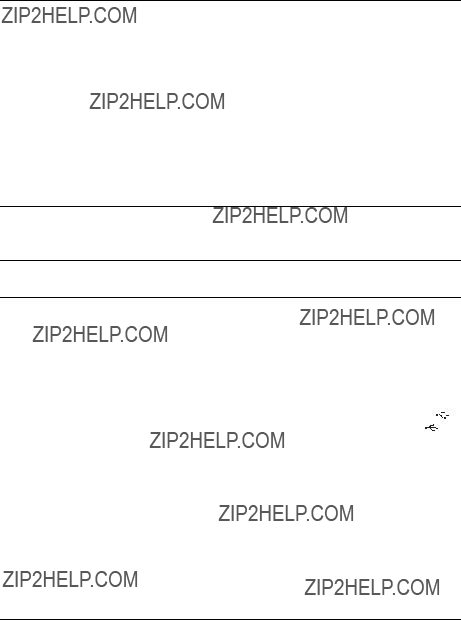
Control for HDMI
System Audio Control function. ??? For details, see ???Using the Control for HDMI Function for ???BRAVIA??? Sync??? (page 51).
Your TV???s input select does not ??? Set [CONTROL FOR HDMI] in [HDMI SETUP] to [OFF] (page 64). change automatically when you
connect the system and TV with a SCART (EURO AV) cable.
Messages
??? the memory capacity is very large.
??? the internal memory is fragmented.
76GB
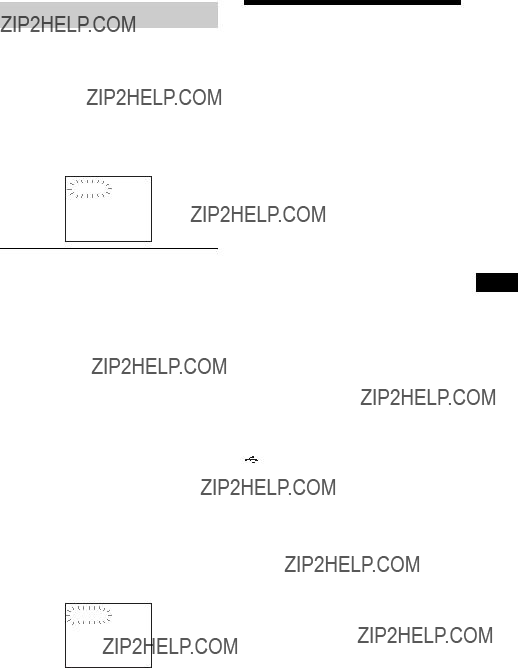
(When letters/numbers appear in the display)
When the
C:13:50
When the version number appears on the TV screen
When you turn on the system, the version number [VER.X.XX] (X is a number) may appear on the TV screen. Although this is not a malfunction and for Sony service use only, normal system operation will not be possible. Turn off the system, and then turn on the system again to operate.
VER.X.XX
Specifications
Amplifier Section
POWER OUTPUT (rated):
Front L + Front R 108 W + 108 W (at 3 ohms, 1 kHz, 1% THD)
POWER OUTPUT (reference):
Front L/Front R/Center/
Surround L/Surround R: 167 watts (per channel at 3 ohms, 1 kHz)
Subwoofer: 165 watts (at 3 ohms, 80 Hz)
Inputs (Digital)
TV (Audio Return Channel/OPTICAL IN) Input Stream: Dolby
Digital 5.1ch/DTS 5.1ch/ Linear PCM 2ch (Sampling Frequency: less than 48 kHz)
Super Audio CD/DVD System
Laser Diode Properties Emission Duration: Continuous
Laser Output: Less than 44.6 ??W
*This output is the value measurement at a distance of 200 mm from the objective lens surface on the Optical
Information Additional
77GB
Speakers
Front
Subwoofer
Subwoofer Bass reflex 160 mm cone type
3 ohms
169 mm ?? 300 mm ?? 320 mm (w/h/d)
5.3 kg
220 V - 240 V AC,
50/60 Hz
On: 170 W
Standby: 0.25 W*
On: 175 W
Standby: 0.25 W*
*Valid when the system is in the following status:
??????DEMO??? is set to ???OFF.???
???[CONTROL FOR HDMI] is set to [OFF].
???
Dimensions (approx.)
Mass (approx.)
Supported file format
MP3 (MPEG 1 Audio
DivX (except for United Kingdom models)
Design and specifications are subject to change without notice.
???Standby power consumption 0.25 W.
???Halogenated flame retardants are not used in the certain printed wiring boards.
???Over 85% power efficiency of amplifier block is achieved with the full digital amplifier,
78GB

Playback Priority of File Types
The table below describes the playback priority of file types under the [MEDIA] setting.
1)Except for North American models.
3)When using a disc, you can play MP3 files only.
Information Additional
79GB

Language Code List
The language spellings conform to the ISO 639: 1988 (E/F) standard.
Parental Control Area Code List
80GB

Index
A
ATTENUATE 60 AUDIO 63 AUDIO (HDMI) 64 AUDIO DRC 66
AUTO CALIBRATION 65 AUTO STBY 61
B
C
CONTROL FOR HDMI 64 Control for HDMI 51 Control Menu 17 CUSTOM 62
D
D. C. A. C. (Digital Cinema Auto Calibration) 65
DEMO 61 DIMMER 61 DivX?? 9, 67 DUAL MONO 60 DVD???s menu 38
E
F
H
HDMI
YCBCR/RGB (HDMI) 64
I
J
81GB

(1)
Sony Corporation Printed in China